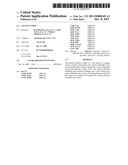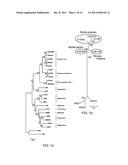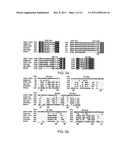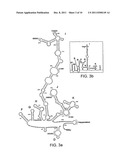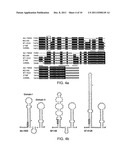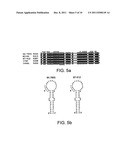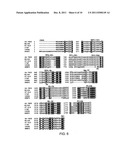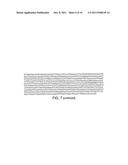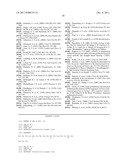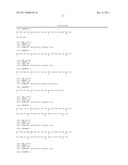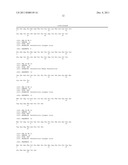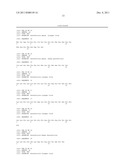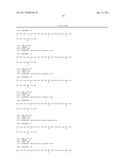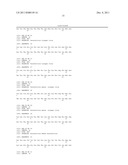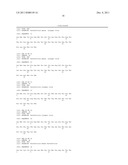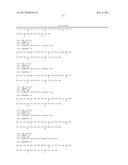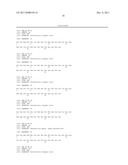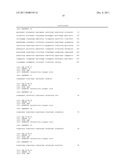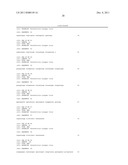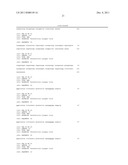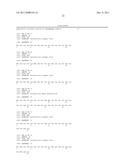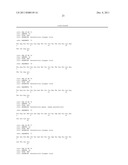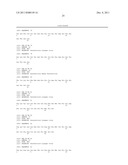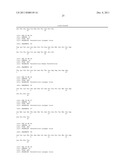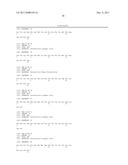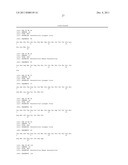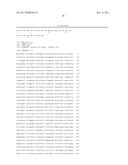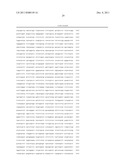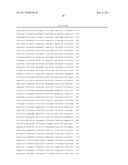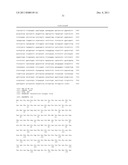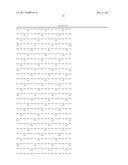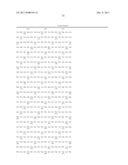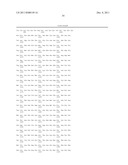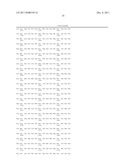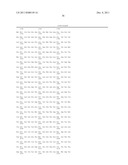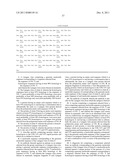Patent application title: LJUNGAN VIRUS
Inventors:
Bo Niklasson (Kalmer, SE)
Conny Tolf (Kalmer, SE)
Michael Lindberg (Kalmer, SE)
Assignees:
Apodemus AB
IPC8 Class: AA61K39125FI
USPC Class:
4241391
Class name: Drug, bio-affecting and body treating compositions immunoglobulin, antiserum, antibody, or antibody fragment, except conjugate or complex of the same with nonimmunoglobulin material binds antigen or epitope whose amino acid sequence is disclosed in whole or in part (e.g., binds specifically-identified amino acid sequence, etc.)
Publication date: 2011-12-08
Patent application number: 20110300149
Abstract:
The present invention relates to a new group of Ljungan viruses, proteins
expressed by the viruses, antibodies to the viruses and proteins,
vaccines against the viruses, diagnostic kits for detecting the viruses,
uses of the viruses, proteins, antibodies and vaccines in therapy, uses
of the viruses, proteins, antibodies and vaccines in treating diseases
caused by the viruses and methods of treatment for treating diseases
caused by the viruses.Claims:
1. A Ljungan virus comprising a genomic nucleotide sequence corresponding
to a sequence selected from: the sequence of FIG. 7; and homologous
sequences having at least 80% homology to the sequence of FIG. 7, and
wherein the Ljungan virus causes disease in mammals.
2. The Ljungan virus of claim 1, wherein the homologous sequences have at least 83% homology to the sequence of FIG. 7, more preferably, at least 85% homology, even more preferably, at least 90% homology, more preferably still, at least 95% homology and, even more preferably, 98% homology.
3. A protein having an amino acid sequence which is at least 95% homologous to and having a conformation that is substantially the same as a Ljungan virus protein derived from the polyprotein amino acid sequence of FIG. 8.
4. The protein of claim 3 having an amino acid sequence which is at least 97% homologous to a Ljungan virus protein derived from the polyprotein amino acid sequence of FIG. 8, more preferably, at least 98% homologous, even more preferably, at least 99% homologous to a Ljungan virus protein derived from the polyprotein amino acid sequence of FIG. 8.
5. The protein of claim 3, wherein the protein is homologous to a structural Ljungan virus protein.
6. The protein of claim 3, wherein the protein is homologous to any one of the VP0, VP1 and VP3 capsid proteins.
7. A virus-like particle comprising proteins which are homologous to the VP0, VP1 and VP3 capsid proteins and which are as defined in claim 6.
8. A nucleotide sequence corresponding to the genomic nucleotide sequence of the Ljungan virus of claim 1.
9. An antibody directed against an epitope on an antigen selected from the group consisting of: a Ljungan virus comprising a genomic nucleotide sequence corresponding to a sequence selected from: the sequence of FIG. 7; and homologous sequences having at least 80% homology to the sequence of FIG. 7, and wherein the Ljungan virus causes disease in mammals; antigenic fragment of said Ljungan virus; a protein having an amino acid sequence which is at least 95% homologous to and having a conformation that is substantially the same as a Ljungan virus protein derived from the polyprotein amino acid sequence of FIG. 8; an antigenic fragment of said protein; a virus-like particle comprising proteins which are homologous to the VP0, VP1 and VP3 capsid proteins and which are as defined in claim 6; a nucleotide sequence of corresponding to the genomic nucleotide sequence of the Ljungan virus of claim 1; and an antigenic fragment of said nucleotide sequence of claim 8.
10. The antibody of claim 8, wherein the antibody is specific for the Ljungan virus from which the antigen is derived.
11. A vaccine comprising a component selected from: a virus comprising a genomic nucleotide sequence corresponding to a sequence selected from: the sequence of FIG. 7; and homologous sequences having at least 80% homology to the sequence of FIG. 7, and wherein the Ljungan virus causes disease in mammals; said virus in an attenuated form; said virus in a killed form; an antigenic fragment of said virus; a protein having an amino acid sequence which is at least 95% homologous to and having a conformation that is substantially the same as a Ljungan virus protein derived from the polyprotein amino acid sequence of FIG. 8; an antigenic fragment of said protein; a virus-like particle comprising proteins which are homologous to the VP0, VP1 and VP3 capsid proteins and homologous to any one of the VPO, VP1, and VP3 capsid proteins; a nucleotide sequence corresponding to the genomic nucleotide sequence of the Ljungan virus of claim 1; an antigenic fragment of said nucleotide sequence of; and a combination of two or more of the preceding components.
12. A diagnostic kit comprising a component selected from: an antibody corresponding to the genomic nucleotide sequence of the Ljungan virus of claim 1; a nucleotide probe directed against a unique portion of the genome of a virus comprising a genomic nucleotide sequence corresponding to a sequence selected from: the sequence of FIG. 7; and homologous sequences having at least 80% homology to the sequence of FIG. 7, and wherein the Ljungan virus causes disease in mammals; and specific primers for amplification of a portion of the genome of said virus.
13. A pharmaceutical composition comprising an antigen selected from: a virus comprising a genomic nucleotide sequence corresponding to a sequence selected from: the sequence of FIG. 7; and homologous sequences having at least 80% homology to the sequence of FIG. 7, and wherein the Ljungan virus causes disease in mammals; said virus in an attenuated form; said virus of in a killed form; an antigenic fragment of said virus; a protein having an amino acid sequence which is at least 95% homologous to and having a conformation that is substantially the same as a Ljungan virus protein derived from the polyprotein amino acid sequence of FIG. 8; an antigenic fragment of said protein; a virus-like particle comprising proteins which are homologous to the VP0, VP1 and VP3 capsid proteins and which are as defined in claim 6; a nucleotide sequence corresponding to the genomic nucleotide sequence of the Ljungan virus of claim 1; an antigenic fragment of said nucleotide sequence; an antibody directed against an epitope on an antigen selected from the group consisting of: a Ljungan virus comprising a genomic nucleotide sequence corresponding to a sequence selected from: the sequence of FIG. 7; and homologous sequences having at least 80% homology to the sequence of FIG. 7, and wherein the Ljungan virus causes disease in mammals; antigenic fragment of said Ljungan virus; a protein having an amino acid sequence which is at least 95% homologous to and having a conformation that is substantially the same as a Ljungan virus protein derived from the polyprotein amino acid sequence of FIG. 8; an antigenic fragment of said protein; a virus-like particle comprising proteins which are homologous to the VP0, VP1 and VP3 capsid proteins and which are as defined in claim 6; a nucleotide sequence corresponding to the genomic nucleotide sequence of the Ljungan virus of claim 1; and an antigenic fragment of said nucleotide sequence; and a vaccine comprising a component selected from: a virus comprising a genomic nucleotide sequence corresponding to a sequence selected from: the sequence of FIG. 7; and homologous sequences having at least 80% homology to the sequence of FIG. 7, and wherein the Ljungan virus causes disease in mammals; said virus in an attenuated form; said virus in a killed form; an antigenic fragment of said virus; a protein having an amino acid sequence which is at least 95% homologous to and having a conformation that is substantially the same as a Ljungan virus protein derived from the polyprotein amino acid sequence of FIG. 8; an antigenic fragment of said protein; a virus-like particle comprising proteins which are homologous to the VP0, VP1 and VP3 capsid proteins and homologous to any one of the VPO, VP1, and VP3 capsid proteins; a nucleotide sequence corresponding to the genomic nucleotide sequence of the Ljungan virus of claim 1; an antigenic fragment of said nucleotide sequence; and a combination of two or more of the preceding components for use in therapy.
14. A pharmaceutical composition comprising an antigen selected from a virus comprising a genomic nucleotide sequence corresponding to a sequence selected from: the sequence of FIG. 7; and homologous sequences having at least 80% homology to the sequence of FIG. 7, and wherein the Ljungan virus causes disease in mammals; said virus in an attenuated form; said virus in a killed form; an antigenic fragment of said virus; a protein having an amino acid sequence which is at least 95% homologous to and having a conformation that is substantially the same as a Ljungan virus protein derived from the polyprotein amino acid sequence of FIG. 8; an antigenic fragment of said protein; a virus-like particle comprising proteins which are homologous to the VP0, VP1 and VP3 capsid proteins and which are as defined in claim 6; a nucleotide sequence corresponding to the genomic nucleotide sequence of the Ljungan virus of claim 1; an antigenic fragment of said nucleotide sequence; an antibody directed against an epitope on an antigen selected from the group consisting of: a Ljungan virus comprising a genomic nucleotide sequence corresponding to a sequence selected from: the sequence of FIG. 7; and homologous sequences having at least 80% homology to the sequence of FIG. 7, and wherein the Ljungan virus causes disease in mammals; antigenic fragment of said Ljungan virus; a protein having an amino acid sequence which is at least 95% homologous to and having a conformation that is substantially the same as a Ljungan virus protein derived from the polyprotein amino acid sequence of FIG. 8; an antigenic fragment of said protein; a virus-like particle comprising proteins which are homologous to the VP0, VP1 and VP3 capsid proteins and homologous to any one of the VPO, VP1, and VP3 capsid proteins; a nucleotide sequence corresponding to the genomic nucleotide sequence of the Ljungan virus of claim 1; and an antigenic fragment of said nucleotide sequence; and a vaccine comprising a component selected from: a virus comprising a genomic nucleotide sequence corresponding to a sequence selected from: the sequence of FIG. 7; and homologous sequences having at least 80% homology to the sequence of FIG. 7, and wherein the Ljungan virus causes disease in mammals; said virus in an attenuated form; said virus in a killed form; an antigenic fragment of said virus; a protein having an amino acid sequence which is at least 95% homologous to and having a conformation that is substantially the same as a Ljungan virus protein derived from the polyprotein amino acid sequence of FIG. 8; an antigenic fragment of said protein; a virus-like particle comprising proteins which are homologous to the VP0, VP1 and VP3 capsid proteins and homologous to any one of the VPO, VP1, and VP3 capsid proteins; a nucleotide sequence corresponding to the genomic nucleotide sequence of the Ljungan virus of claim 1; an antigenic fragment of said nucleotide sequence; and a combination of two or more of the preceding components for use in therapy for use in the prophylactic or therapeutic treatment of a disease caused by Ljungan virus.
15. The pharmaceutical composition of claim 14, wherein the disease caused by the Ljungan virus is selected from myocarditis, cardiomyopathia, Guillain Barre syndrome, diabetes mellitus, multiple sclerosis, chronic fatigue syndrome, myasthenia gravis, amyothrophic lateral sclerosis, dermatomyositis, polymyositis, malformation such as anencephaly and hydrocephaly, spontaneous abortion, intrauterine fetal death, lethal central nervous disease and sudden infant death syndrome.
16. A method of prophylactic or therapeutic treatment of a disease caused by a Ljungan virus comprising a genomic nucleotide sequence corresponding to a sequence selected from: the sequence of FIG. 7; and homologous sequences having at least 80% homology to the sequence of FIG. 7, and wherein the Ljungan virus causes disease in mammals in a mammal, the method comprising administering to the mammal a prophylactically or therapeutically effective amount of a pharmaceutical composition comprising an antigen selected from a virus comprising a genomic nucleotide sequence corresponding to a sequence selected from: the sequence of FIG. 7; and homologous sequences having at least 80% homology to the sequence of FIG. 7, and wherein the Ljungan virus causes disease in mammals; said virus in an attenuated form; said virus in a killed form; an antigenic fragment of said virus; a protein having an amino acid sequence which is at least 95% homologous to and having a conformation that is substantially the same as a Ljungan virus protein derived from the polyprotein amino acid sequence of FIG. 8; an antigenic fragment of said protein; a virus-like particle comprising proteins which are homologous to the VP0, VP1 and VP3 capsid proteins and homologous to any one of the VPO, VP1, and VP3 capsid proteins; a nucleotide sequence corresponding to the genomic nucleotide sequence of the Ljungan virus of claim 1; an antigenic fragment of said nucleotide sequence; an antibody directed against an epitope on an antigen selected from the group consisting of: a Ljungan virus comprising a genomic nucleotide sequence corresponding to a sequence selected from: the sequence of FIG. 7; and homologous sequences having at least 80% homology to the sequence of FIG. 7, and wherein the Ljungan virus causes disease in mammals; antigenic fragment of said Ljungan virus; a protein having an amino acid sequence which is at least 95% homologous to and having a conformation that is substantially the same as a Ljungan virus protein derived from the polyprotein amino acid sequence of FIG. 8; an antigenic fragment of said protein; a virus-like particle comprising proteins which are homologous to the VP0, VP1 and VP3 capsid proteins and homologous to any one of the VPO, VP1, and VP3 capsid proteins; a nucleotide sequence corresponding to the genomic nucleotide sequence of the Ljungan virus of claim 1; and an antigenic fragment of said nucleotide sequence; and a vaccine comprising a component selected from: a virus comprising a genomic nucleotide sequence corresponding to a sequence selected from: the sequence of FIG. 7; and homologous sequences having at least 80% homology to the sequence of FIG. 7, and wherein the Ljungan virus causes disease in mammals; said virus in an attenuated form; said virus in a killed form; an antigenic fragment of said virus; a protein having an amino acid sequence which is at least 95% homologous to and having a conformation that is substantially the same as a Ljungan virus protein derived from the polyprotein amino acid sequence of FIG. 8; an antigenic fragment of said protein; a virus-like particle comprising proteins which are homologous to the VP0, VP1 and VP3 capsid proteins and homologous to any one of the VPO, VP1, and VP3 capsid proteins; a nucleotide sequence corresponding to the genomic nucleotide sequence of the Ljungan virus of claim 1; an antigenic fragment of said nucleotide sequence; and a combination of two or more of the preceding components for use in therapy.
17. A method of prophylactic and/or therapeutic treatment of a mammal for a disease that is caused by infection with the Ljungan virus of claim 1, comprising administration to said mammal of an antivirally effective amount of an antiviral compound effective against the Ljungan virus to eliminate or inhibit proliferation of said virus in said mammal and at the same time prevent and/or treat said disease in said mammal.
18. The method of claim 17, wherein the antiviral compound is Pleconaril or a derivative thereof.
19. An antiviral compound effective against the Ljungan virus of claim 1 for use in the treatment of a disease in a mammal that is caused by infection of the Ljungan virus.
20. The antiviral compound of claim 19, wherein the antiviral compound is Pleconaril or a derivative thereof.
Description:
BACKGROUND OF THE INVENTION
[0001] 1. Technical Field
[0002] The present invention relates to a new group of Ljungan viruses, proteins expressed by the viruses, antibodies to the viruses and proteins, vaccines against the viruses, diagnostic kits for detecting the viruses, uses of the viruses, proteins, antibodies and vaccines in therapy, uses of the viruses, proteins, antibodies and vaccines in treating diseases caused by the viruses and methods of treatment for treating diseases caused by the viruses.
[0003] 2. Description of the Related Art
[0004] Ljungan virus (LV) is one of two species within the Parechovirus genus of Picornaviridae, a large family consisting of more than 300 serotypes divided into nine different genera (Stanway et al., 2005). Human parechovirus (HPeV), the second species in the Parechovirus genus, is a frequent human pathogen often isolated from children with diarrhoea and gastroenteritis (Stanway & Hyypia, 1999). Recently, several new HPeV genotypes have been characterized (Al-Sunaidi et al., 2007, Watanabe et al., 2007), and one of these genotypes, HPeV3, seem to be widely distributed as it has been isolated in Japan, Europe and North America (Abed & Boivin, 2005, Benschop et al., 2006, Boivin et al., 2005, Ito et al., 2004).
[0005] LV was first isolated from bank voles (Myodes glareolus) trapped in Medelpad and Vasterbotten counties in Sweden when searching for an infectious agent causing human disease (Niklasson et al., 1998, Niklasson et al., 1999). LV has been suggested as an etiological agent of human diseases based on coinciding fluctuations of vole population in northern parts of Sweden and increasing incidences of type I diabetes mellitus, myocarditis and Guillain-Barre syndrome (Niklasson et al., 1998). Recently, LV antigens were detected by immunohistochemistry in fetal tissue samples in cases of human intrauterine fetal death (Niklasson et al., 2007).
[0006] Three LV strains were initially isolated from Swedish voles, the prototype strain, 87-012, and two genetically related strains, 174F and 145SL. Genome sequence analyses showed that the 87-012 and 174F strain were almost identical (genotype 1a), while the 145SL strain (genotype 1b) was clearly related, but genetically distinct from the two other strains (Johansson et al., 2002). Phylogenetic analyses based on the 2C protease (2Cpro) and 3D polymerase (3Dpol) sequences demonstrated that LV is closely related to HPeV, although clearly separated from this species (Johansson et al., 2002, Lindberg & Johansson, 2002) and because of these genetic differences, LV was assigned to a new species within the Parechovirus genus (Stanway et al., 2005). A fourth LV strain, M1146, isolated from montane vole (Microtus montanus) in Oregon, USA, was recently characterized (Johansson et al., 2003). The genomic sequence of M1146 is related, but distinct from all Swedish strains and constitutes therefore a second genotype within the LV species. Molecular characterization of isolated LV strains has revealed distinct features compared to other picornaviruses. Such features include a virus capsid comprising only three different structural proteins (Ekstrom et al., 2007a, Johansson et al., 2004, Tolf et al., 2008) and a set of two different 2A protein motifs encoded by the LV genome (Johansson et al., 2003, Johansson et al., 2002).
[0007] The inventors have now discovered and determined the genomic sequence of another virus, strain 64-7855. The 64-7855 virus was first isolated from a southern red-backed vole (Myodes gappen) trapped during arbovirus studies in the north-eastern part of USA (Whitney et al., 1970). However, at this time no characterisation of the virus was carried out and so it was not possible to classify the virus. Therefore, it was not known in which virus group the virus fell.
[0008] The inventors have found that the 64-7855 virus causes lethal central nervous disease in guinea pigs. However, the virus causes the lethal central nervous disease without any signs of encephalitis. Animal models of picornavirus infection (e.g. enterovirus and cardiovirus) normally show encephalitis (Niklasson et al., 1999) when picornavirus infection leads to lethal central nervous disease. Since the 64-7855 virus does not show encephalitis with lethal central nervous disease, this virus does not display the normal characteristics of a picornavirus.
[0009] When the inventors carried out genetic characterization of the 64-7855 strain, it revealed that the 64-7855 virus had a LV-like genome organization and phylogenetic analyses of the VP1 and 3Dpol protein sequences demonstrated that the 64-7855 strain was a picornavirus and, in particular, a LV. This finding was unexpected and surprising since infection with the 64-7855 virus causes lethal central nervous disease without any signs of encephalitis which is contrary to the normal finding with picornaviruses. The inventors have now determined that the 64-7855 virus constitutes a novel LV and is the fifth LV to be identified.
SUMMARY OF THE INVENTION
[0010] The present invention is directed to this new LV and other closely related LVs. The present invention provides a Ljungan virus (LV) comprising a genomic nucleotide sequence corresponding to a sequence selected from the sequence of FIG. 7, and homologous sequences having at least 80% homology to the sequence of FIG. 7, and wherein the LV causes disease in mammals.
[0011] The sequence of FIG. 7 is a cDNA sequence derived from the RNA genome of the 64-7855 LV. Therefore, the RNA genomic sequence of the 64-7855 LV is identical to the cDNA sequence of FIG. 7 except that the base thymine (T) is replaced by the base uracil (U). In this way, the nucleotide sequence of the LV corresponds to the sequence of FIG. 7.
[0012] LV 64-7855 constitutes a new LV strain and the most closely related known LV strain (M-1146) only has a genomic sequence which is 77% homologous to the genomic sequence of LV 64-7855. Therefore, the LV defined above covers this new LV and closely related LV strains. Surprisingly, this new LV strain has been found to cause lethal central nervous disease in guinea pigs without any signs of encephalitis.
[0013] The LV of the present invention has a genomic nucleotide sequence which is at least 80% homologous to the genomic nucleotide sequence of LV 64-7855. The term "homology" as used herein refers to sequence identity. This means that at least 80% of the genomic sequence of the LV of the present invention is identical to the genomic sequence of LV 64-7855. Preferably, the LV of the present invention comprises a genomic nucleotide sequence corresponding to a sequence selected from: the sequence of FIG. 7; and homologous sequences having at least 83% homology to the sequence of FIG. 7. More preferably, the homologous sequences have at least 85% homology to the sequence of FIG. 7, more preferably still, at least 87% homology to the sequence of FIG. 7, even more preferably, at least 90% homology to the sequence of FIG. 7, more preferably still, at least 92% homology to the sequence of FIG. 7, even more preferably, at least 95% homology to the sequence of FIG. 7, more preferably still, at least 97% homology to the sequence of FIG. 7, even more preferably, at least 98% homology to the sequence of FIG. 7, more preferably still, at least 99% homology to the sequence of FIG. 7 and, most preferably, the LV of the present invention comprises a genomic nucleotide sequence corresponding to the sequence of FIG. 7.
[0014] Preferably, the LV of the present invention is isolated, i.e. it is substantially free of its natural environment. Preferably, the LV is a naturally occurring LV.
[0015] The LV can cause a number of diseases in mammals, such as rodents and humans. For example, the disease caused by the LV can be one of myocarditis, cardiomyopathia, Guillain Barre syndrome, diabetes mellitus, multiple sclerosis, chronic fatigue syndrome, myasthenia gravis, amyothrophic lateral sclerosis, dermatomyositis, polymyositis, malformation such as anencephaly and hydrocephaly, spontaneous abortion, intrauterine fetal death, lethal central nervous disease and sudden infant death syndrome.
[0016] Further LVs according to the invention can be discovered and isolated by finding a source of the virus. Typically, the source of the virus is small rodents which act as the natural reservoir or vector of the LV. The source for virus isolation/discovery can be selected/identified in different ways, such as:
[0017] 1. Looking for a wild rodent such as a mouse, rat or a vole with signs and symptoms similar to the diseases linked with LV in humans (e.g. diabetes or myocarditis).
[0018] 2. Screening large numbers of wild rodents by PCR using several different primer combinations targeting the conserved region of the LV genome. Preferably, these primers are specific for the LV of the invention.
[0019] 3. Screening a large number of wild rodents using specific antisera. Antisera are collected from human patients with a disease linked with LV and who are living in the same geographical area as the rodents. LV infected rodents are identified by immunostaining (e. g. immunohistochemistry) of formalin fixed organs. A portion of the organ to be tested is kept without being fixed in a -70° C. freezer. The unfixed material is used for virus isolation if the immunohistochemistry gives a positive result.
[0020] Tissue for virus isolation is grinded and diluted in sterile saline or PBS. One-day old suckling mice are injected with 2-4 microlitres of the tissue suspension intracerebrally.
[0021] Generally, suckling mice that are inoculated with a virus will all die within a week of inoculation. However, LV infection displays different characteristics so that any signs or symptoms of infection in the baby mice do not develop until 10 days to 3 weeks after inoculation. The signs and symptoms are very discrete and can include slow weight increase and altered mobility. Further, only 5-10% of the animals develop symptoms. This is very unusual and would in most cases result in a negative interpretation of the isolation attempt.
[0022] Only the brain tissue from suckling mice with signs and symptoms of disease are used for passage in new one-day old suckling mice. When passed, the brains from sick suckling mice are grinded and diluted in sterile saline or PBS. One-day old suckling mice are injected with 2-4 microliters of the tissue suspension intracerebrally. Several such passages may be necessary before disease develops earlier (8-12 days) and in the majority of mice. After several passages in suckling mice LV is inoculated into tissue culture such as Vero cells for amplification and identification.
[0023] LV must be adapted to cell culture by passages of the cells. No or very discrete cytopathogenic effect is seen. The cells (not the tissue culture fluid) are passed weekly into new tissue culture bottles at a rate of 1 to 5. After 3-6 such blind passages the cells are stained using antibodies directed to the isolate. These antisera can be made by immunising adult mice with the suckling mouse brain suspension of a suspected isolate and/or by using human serum from patients with the disease caused by LV living in the same geographic region as the animals used as the source for virus isolation.
[0024] LVs can be identified serologically and/or genetically as they are related to but distinct from other members of the Picornavirus family. For example, genetically the LV genome and the polyprotein encoded thereby exhibit several exceptional features, such as the absence of a predicted maturation cleavage of VPO, a conserved sequence determinant in VP0 that is typically found in VP1 of other Picornaviruses, and a cluster of two unrelated 2A proteins. The 2A1 protein is related to the 2A protein of cardio, erbo and aphthoviruses and the 2A2 protein is related to the 2A protein of parechoviruses, kobuviruses and avian encephalomyelitis virus (Lindberg and Johansson).
[0025] LV is characterized by a chronic or long lasting infection in its rodent host and reservoir. LV can replicate and cause disease in a very broad host spectrum of animal species as well as in humans. LV infects these different species of animals as well as humans and the infection often results in a long lasting or chronic infection.
[0026] LV replicates in a wide variety of tissue culture cells giving a chronic infection with a discrete cytopathogenic effect and low viral output (in the order of 1,000-100,000 viral particles per ml supernatant).
[0027] Data generated by virus cultivation under laboratory conditions show that LV grows/replicates in a number of cell lines that originate from different tissues and different species, e. g. Vero monkey kidney; Vero E6 monkey kidney; MA-104 monkey kidney; CV-1 monkey kidney; GMK monkey kidney; A-549 human lung; Hela human cervical tissue; BHK 21 hamster kidney; RD human muscle; and L-cells mouse skin.
[0028] In living animals and humans, LV replicates in muscle tissue including heart tissue, in neural cells including the brain, in endocrine glands including the beta cells of the pancreas, the thyroid gland, and the supra renal gland.
[0029] Data have shown that LV has been found in endocrine and exocrine pancreas tissue, in endothelial cells of vessels, cells in the brain (including nerve tissue), cells of the liver, cells of the placenta and the umbilical cord, muscle tissue, heart tissue, and tissue of the thyroid gland. This data was generated by detection of virus by LV specific immunohistochemistry tests, thin section electron microscopy and by PCR in humans, bank voles, lemmings, laboratory mice, rabbits, guinea pigs, arctic foxes, and moose. This shows that LV can grow in most cell types of the body and therefore infect all organs of the body.
[0030] The present invention also provides a nucleotide sequence corresponding to the genomic nucleotide sequence of the LV described above. Therefore, the nucleotide sequence codes for a functional LV. Preferably, the nucleotide sequence is RNA. Preferably, the nucleotide sequence is isolated. This nucleotide sequence can be used, for example, as an antigenic component of a vaccine.
[0031] Further, the present invention provides a protein having an amino acid sequence which is at least 95% homologous to and has a conformation that is substantially the same as a LV protein derived from the polyprotein amino acid sequence of FIG. 8. This means that the secondary and tertiary structure of the protein will be substantially the same as the LV protein derived from the polyprotein amino acid sequence of FIG. 8. As will be appreciated by one skilled in the art, given that the protein has at least 95% homology, the conformation of the protein may not be identical to the naturally occurring protein of the 64-7855 strain. However, it should be at least very similar. Preferably, the secondary and tertiary structure is at least 60% identical to the secondary and tertiary structure of the LV protein derived from the polyprotein amino acid sequence of FIG. 8. More preferably, the secondary and tertiary structure is at least 70% identical, even more preferably, at least 80% identical, more preferably still, at least 90% identical, even more preferably, at least 95% identical and, most preferably, 100% identical. Preferably, the protein should be a functional protein. For example, if the protein is a structural protein that normally forms part of the viral coat, it should be able to interact with other structural proteins to form the viral coat. Preferably, the protein is immunogenically the same as the LV protein derived from the polyprotein amino acid sequence of FIG. 8. Therefore, the protein should induce the same immune response as the LV protein derived from the polyprotein amino acid sequence of FIG. 8. For example, the protein may have a slightly different conformation but the antigenic epitopes of the protein may be the same as the LV protein derived from the polyprotein amino acid sequence of FIG. 8. Preferably, the protein is a naturally occurring protein.
[0032] FIG. 8 shows the amino acid sequence of the polyprotein of LV 64-7855. It is from this polyprotein that the proteins of the LV are produced by cleaving the polyprotein at particular sites to release functional proteins. In this way, the LV proteins are derived from the polyprotein. This form of viral protein processing occurs in many viruses, including picornaviruses, and is well known to those skilled in the art. Therefore, a skilled person presented with a LV polyprotein sequence would readily be able to determine the sequences of the proteins contained within the polyprotein and produce such proteins. For example, such proteins include the VP0, VP3 and VP1 capsid proteins, and the viral 3C protease (3Cpro). FIG. 6 shows the protein cleavage sites in the polyprotein for various strains of LV. Further, Johansson et al., 2003 describes the characterisation of a LV.
[0033] The protein of the invention is homologous to a LV protein derived from the polyprotein amino acid sequence of FIG. 8. Proteins derived from the polyprotein sequence of FIG. 8 are the naturally occurring functional proteins of the 64-7855 strain.
[0034] LV 64-7855 constitutes a new LV strain and the most closely related known LV strain (M-1146) has proteins with a sequence which are between 81% and 93.4% homologous to the proteins of the 64-7855 strain. Therefore, the protein of the invention differs from the proteins of other LVs and can be specifically recognised as being from a virus which is closely related to the 64-7855 strain. For example, the protein may have epitopes which are unique to the virus which allow antibodies to specifically bind the protein of the invention but not to proteins of other known LVs. In this way, the proteins comprise epitopes which are specific to the LV of the invention.
[0035] The protein of the present invention has an amino acid sequence which is at least 95% homologous to a LV protein derived from the polyprotein amino acid sequence of FIG. 8. Preferably, the protein is at least 97% homologous a LV protein derived from the polyprotein amino acid sequence of FIG. 8, more preferably, at least 98% homologous, even more preferably, at least 99% homologous and, most preferably, identical to a LV protein derived from the polyprotein amino acid sequence of FIG. 8.
[0036] The protein of the present invention can be homologous to any LV protein. For example, the protein can correspond to any one of the VP0, VP3 and VP1 capsid proteins, and the viral 3C protease (3Cpro). The sequences of the LV proteins can easily be determined from the information given in FIG. 6. Preferably, the protein is homologous to a structural LV protein and, more preferably, the protein is homologous to any one of the VP0, VP1 and VP3 capsid proteins. Preferably, the protein of the present invention is isolated.
[0037] The VP0, VP1 and VP3 capsid proteins form a coat around the core of the virus. Accordingly, these proteins can be used, for example, as a vaccine to elicit an immune response that is specific to the virus so that future infection by the virus is quickly eliminated by the immune system, thus preventing disease.
[0038] The present invention also provides a virus-like particle comprising proteins which are homologous to the VP0, VP1 and VP3 capsid proteins and which are as defined above. Virus-like particles are particles which resemble the complete virus from which they are derived but lack viral nucleic acid, meaning that they are not infectious. Virus-like particles and methods for producing such particles are well known to those skilled in the art, for example as described in Jennings and Bachmann.
[0039] The present invention also provides an antibody directed against an epitope on an antigen selected from the group consisting of: the LV described above; an antigenic fragment of the LV described above; the protein described above; an antigenic fragment of the protein described above; the nucleotide sequence described above; a fragment of the nucleotide sequence described above; and the virus-like particle described above.
[0040] Preferably, the antibody is specific for the antigen so that the antibody only recognises and binds an antigen associated with the LV of the invention. In this way, the fragments of the LV, the protein and the nucleotide sequence should be unique to the LV so that the antibody binds to an epitope on the fragment but not to similar fragments from other LVs or other viruses.
[0041] The term "antibody" is well known in the art. Herein it means an immunoglobulin or any functional fragment thereof. It encompasses any polypeptide that has an antigen-binding site. It includes but is not limited to monoclonal, polyclonal, monospecific, polyspecific, non-specific, humanized, human, single-chain, chimeric, synthetic, recombinant, hybrid, mutated, grafted, and in vitro generated antibodies. The term "antibody" encompasses antibody fragments such as Fab, F (ab') 2, Fv, scFv, Fd, dAb, and any other antibody fragments that retain antigen-binding function. Typically, such fragments would comprise an antigen-binding domain.
[0042] Furthermore, the present invention provides a composition for inducing an immune response comprising a component selected from: the LV described above; the LV described above in an attenuated form; the LV described above in a killed form; an antigenic fragment of the LV described above; the protein described above; an antigenic fragment of the protein described above; the nucleotide sequence described above; an antigenic fragment of the nucleotide sequence described above; the virus-like particle described above and a combination of two or more of the preceding components.
[0043] Preferably, the composition for inducing an immune response is a vaccine.
[0044] The term "antigenic fragment" means any fragment which can stimulate an immune response to the LV. The antigenic fragment can be any size as long as it provokes an immune response which is directed to the LV. For example, an antigenic fragment of the LV could be, for example, a fragment of RNA, a protein, a protein subunit, an oligopeptide, etc. The antigenic fragment should be unique to the LV of the invention.
[0045] Preferably the composition or vaccine further comprises an adjuvant. Suitable adjuvants are well known to those skilled in the art. The composition or vaccine can induce an immune response in a mammal so that infection of the mammal with the LV of the invention can be efficiently dealt with and eliminated without the mammal suffering from a disease associated with infection by the LV.
[0046] The present invention also provides a diagnostic kit comprising a component selected from: an antibody described above; a nucleotide probe directed against a unique portion of the genome of the LV described above; and specific primers for amplification of a portion of the genome of the LV described above.
[0047] The nucleotide probe can be any kind of probe which can bind to a unique portion of the genome of the LV to allow detection of the LV RNA. Since the nucleotide probe is directed against a unique portion of the genome of the LV, it will be specific for the LV so that it will not bind to the genome of other LVs and other viruses. The nucleotide probe can be an oligonucleotide with a complementary sequence to the sequence contained in the portion of the viral genome against which the probe is directed. For example, the oligonucleotide could be DNA, RNA, a phosphorodiamidate morpholino oligo (PMO), a 2'O-Me oligonucleotide or a locked nucleic acid (LNA). Preferably, the nucleotide probe is at least a 10 mer, more preferably, at least a 20 mer and, most preferably, at least a 30 mer. Suitable probes are well known to those skilled in the art and could easily be produced based on the sequence of the LV of FIG. 7 or the sequence of a LV isolated in the future.
[0048] Preferably, the antibody or the probe are tagged or labelled with a molecular marker to allow the antibody or the probe to be easily detected. Suitable tags or labels are well known to those skilled in the art. For example, the antibody or probe may be labelled with a radioactive isotope such as 32P.
[0049] The primers can be any suitable primers for amplifying a portion of the genome of the LV described above using, for example, PCR. Based on the sequence in FIG. 7, which corresponds to the genomic sequence of LV 64-7855, a person skilled in the art would be able to create specific primers to allow the detection of a LV of the invention. The primers are specific for the LV of the invention, i.e. by binding to a unique portion of the genome of the LV. This allows detection of only the LV of the invention so that other viruses are not detected, thereby avoiding a false positive result. Suitable primers could easily be produced by one skilled in the art based on the sequence of the LV of FIG. 7 or the sequence of a LV isolated in the future.
[0050] This allows the diagnostic kit to be used to identify the LV of the invention, for example, LV infection in a mammal. The kit can comprise one, two or all three of the components discussed above.
[0051] In another aspect, the present invention provides a pharmaceutical composition comprising an antigen selected from: the LV described above; the LV described above in an attenuated form; the LV described above in a killed form; an antigenic fragment of the LV described above; the protein described above; an antigenic fragment of the protein described above; the nucleotide sequence described above; an antigenic fragment of the nucleotide sequence described above; the antibody described above; and the vaccine described above for use in therapy.
[0052] The present invention also provides a pharmaceutical composition comprising an antigen selected from: the LV described above; the LV described above in an attenuated form; the LV described above in a killed form; an antigenic fragment of the LV described above; the protein described above; an antigenic fragment of the protein described above; the nucleotide sequence described above; an antigenic fragment of the nucleotide sequence described above; the antibody described above; and the vaccine described above for use in the prophylactic or therapeutic treatment of a disease caused by the LV described above.
[0053] The disease caused by the LV can be any of myocarditis, cardiomyopathia, Guillain Barre syndrome, diabetes mellitus, multiple sclerosis, chronic fatigue syndrome, myasthenia gravis, amyothrophic lateral sclerosis, dermatomyositis, polymyositis, malformation such as anencephaly and hydrocephaly, spontaneous abortion, intrauterine fetal death, lethal central nervous disease and sudden infant death syndrome.
[0054] Pharmaceutical compositions according to the invention comprise the antigen described above with any pharmaceutically acceptable carrier, adjuvant or vehicle. Suitable pharmaceutically acceptable carriers, adjuvants and vehicles are well known to those skilled in the art. Pharmaceutically acceptable carriers, adjuvants and vehicles that may be used in the pharmaceutical compositions of this invention include, but are not limited to, ion exchangers, alumina, aluminum stearate, lecithin, serum proteins, such as human serum albumin, buffer substances such as phosphates, glycine, sorbic acid, potassium sorbate, partial glyceride mixtures of saturated vegetable fatty acids, water, salts or electrolytes, such as protamine sulfate, disodium hydrogen phosphate, potassium hydrogen phosphate, sodium chloride, zinc salts, colloidal silica, magnesium trisilicate, polyvinyl pyrrolidone, cellulose-based substances, polyethylene glycol, sodium carboxymethylcellulose, polyacrylates, waxes, polyethylene-polyoxypropylene-block polymers, polyethylene glycol and wool fat.
[0055] The pharmaceutical compositions of this invention may be administered orally, parenterally, by inhalation spray, topically, rectally, nasally, buccally, vaginally or via an implanted reservoir. Preferably, they are administered orally or by injection. The pharmaceutical compositions of this invention may contain any conventional non-toxic pharmaceutically-acceptable carriers, adjuvants or vehicles. The term parenteral as used herein includes subcutaneous, intracutaneous, intravenous, intramuscular, intra-articular, intrasynovial, intrasternal, intrathecal, intralesional and intracranial injection or infusion techniques.
[0056] The pharmaceutical compositions may be in the form of a sterile injectable preparation, for example, as a sterile injectable aqueous or oleaginous suspension. This suspension may be formulated according to techniques known in the art using suitable dispersing or wetting agents (such as, for example, Tween 80) and suspending agents. The sterile injectable preparation may also be a sterile injectable solution or suspension in a non-toxic parenterally-acceptable diluent or solvent, for example, as a solution in 1,3-butanediol. Among the acceptable vehicles and solvents that may be employed are mannitol, water, Ringer's solution and isotonic sodium chloride solution. In addition, sterile, fixed oils are conventionally employed as a solvent or suspending medium. For this purpose, any bland fixed oil may be employed including synthetic mono- or diglycerides. Fatty acids, such as oleic acid and its glyceride derivatives are useful in the preparation of injectables, as are natural pharmaceutically-acceptable oils, such as olive oil or castor oil, especially in their polyoxyethylated versions. These oil solutions or suspensions may also contain a long-chain alcohol diluent or dispersant such as Ph. Helv or a similar alcohol.
[0057] The pharmaceutical compositions of this invention may be orally administered in any orally acceptable dosage form including, but not limited to, capsules, tablets, and aqueous suspensions and solutions. In the case of tablets for oral use, carriers which are commonly used include lactose and corn starch. Lubricating agents, such as magnesium stearate, are also typically added. For oral administration in a capsule form, useful diluents include lactose and dried corn starch. When aqueous suspensions are administered orally, the antigen is combined with emulsifying and suspending agents. If desired, certain sweetening and/or flavouring and/or colouring agents may be added.
[0058] The present invention also provides a method of prophylactic or therapeutic treatment of a disease caused by the LV described above in a mammal, the method comprising administering to the mammal a prophylactically or therapeutically effective amount of a pharmaceutical composition comprising an antigen selected from: the LV described above; the LV described above in an attenuated form; the LV described above in a killed form; an antigenic fragment of the LV described above; the protein described above; an antigenic fragment of the protein described above; the nucleotide sequence described above; an antigenic fragment of the nucleotide sequence described above; the antibody described above; and the vaccine described above.
[0059] The mammal can be any mammal which can be infected with LV and in which LV can cause disease. Preferably, the mammal is human.
[0060] The present invention also provides a method of prophylactic and/or therapeutic treatment of a mammal for a disease that is caused by infection with the LV of the invention, comprising administration to said mammal of an antivirally effective amount of an antiviral compound effective against the LV to eliminate or inhibit proliferation of said virus in said mammal and at the same time prevent and/or treat said disease in said mammal.
[0061] Preferably the mammal is selected from the group consisting of humans, horses, cattle, pigs, cats, dogs and rodents such as rats and mice.
[0062] The disease caused by LV infection may be caused by the infection of a tissue or cell type. It is known that LV is capable of growth in most cell types of the body and can therefore infect all organs of the body.
[0063] The present invention also provides an antiviral compound effective against a LV of the invention for use in the treatment of a disease in a mammal that is caused by infection of the LV of the invention.
[0064] Preferably, the antiviral compound is Pleconaril or a derivative thereof which is effective against the LV of the invention. Suitable antiviral compounds, such as Pleconaril and derivatives thereof, are set out in International Patent Application WO2004/073710.
BRIEF DESCRIPTION OF THE DRAWINGS
[0065] The invention will now be described, by way of example only, with reference to the accompanying figures in which:
[0066] FIG. 1 shows the phylogenetic relationships of the 64-7855 strain with representative members of the nine genera of the Picornaviridae and the so far unclassified duck hepatitis virus type 1. (a) Tree based on 3Dpol protein sequences is rooted with two picorna-like insect viruses, the Scarbrood virus (SBV) and the infectious flacherie virus (InFV). (b) Unrooted tree based on VP1 protein of members of the Parechovirus genus. Gray spheres denote the vole species (indicated in italics) from which the LV strains have been isolated. Numbers at nodes are percentage of 500 bootstrap replicates supporting that node and bars under trees represent substitutions per site.
[0067] FIG. 2 shows the predicted polyprotein cleavage sites (a) and secondary structural features of capsid proteins (b), showing sequence variation between American and Swedish LV strains (HPeV1 is included as reference). (a) Vertical lines indicate cleavage sites between viral proteins while dark and gray columns in alignments show identical and similar residues, respectively. (b) Predicted -strands and -helices in LV and HPeV1 capsid proteins are underlined in aligned sequences and corresponding loop-regions are indicated above alignments.
[0068] FIG. 3 shows the predicted stem-loop structure of the 64-7855 5'UTR (a) compared with corresponding outlined structure of the 87-012G 5'UTR (b). Stem-loop elements are labelled according to accepted notation of picornavirus type II IRES. The shaded area of predicted 5'UTR structure of 87-012G indicates the putative 5'end sequence that remains to be determined. The first codon for initiation of translation is indicated at the 3' end of the sequence.
[0069] FIG. 4 shows the aligned nucleotide sequences (a) and predicted secondary structures of the 3'UTR of representative members of the three LV genotypes (b). Dark background columns in alignment indicate conserved residues, while less-than and more-than (< and >) signs denote conserved nucleotides participating in predicted stem of stem-loop domain II. Two additional codons in 5' and ten adenosine of the poly A tail were included in analyses to simulate authentic virus RNA. Stop codon of polyprotein sequences are indicated by a boxed nucleotide triplet.
[0070] FIG. 5 shows alignment (a) and predicted secondary structures (b) of a putative cre of 64-7855 and the LV prototype. (a) Dark colour indicate conserved nucleotides, while less-than and more-than (< and >) signs denote conserved nucleotides participating in predicted stem structures. (b) The AAAC sequence, which is conserved in picornavirus cre, is indicated by stars (*).
[0071] FIG. 6 shows a comparison of terminal regions and predicted cleavage sites of the polyprotein sequence of the 64-7855 strain with those of previously published LV strains (i.e., 87-012, 174F and 145SL) and the HPeV prototype strain 1 (Harris).
[0072] FIG. 7 shows a cDNA nucleotide sequence corresponding to the genomic RNA sequence of LV strain 64-7855.
[0073] FIG. 8 shows the amino acid sequence of the polyprotein of LV strain 64-7855.
DESCRIPTION OF INVENTION
[0074] Ljungan virus (LV) was discovered twenty years ago in Swedish bank voles (Myodes glareolus, previously referred to as Clethrionomys glareolus) during search for an infectious agent causing lethal myocarditis in young athletes. Previously, the genomes of four LV isolates, including the prototype 87-012 strain, have been characterized. In addition to three Swedish LV strains isolated from bank voles, which constitute two different variants of one genotype (1a and 1b), the nucleotide sequence of an American virus (M1146), isolated from a montane vole (Microtus montanus) in western USA, demonstrated the existence of a second LV genotype.
[0075] Here, the inventors present genomic analyses of a fifth LV strain (64-7855) isolated from a southern red-backed vole (Myodes gapperi) trapped during arbovirus studies in the New York state in the north-eastern USA in the 1960s. Sequence analysis of the 64-7855 genome showed an LV-like genome organization and sequence similarity to other LV strains including conserved cleavage sites within the polyprotein. Genetic and phylogenetic analyses of evolutionary relationship between the 64-7855 strain and viruses within the Picornaviridae including previously published LV strains, demonstrated that the 64-7855 strain constitutes a novel LV strain. This strain could be considered to constitute a third genotype within the LV species.
Methods
Viruses and Sequences
[0076] 64-7855 LV was generated by passages in infant mice by intracerebral inoculation, as previously described (Beaty et al., 1989). Briefly, a filtered 10% suspension of infected mouse brain in phosphate-buffered saline was administered into 2-3 days old outbred albino mice (ICR strain) by intracerebral inoculation. After the inoculation, the mice were observed for signs of illness; when the animals were sick or moribund (about 7-8 days), they were sacrificed and their brains collected. The nucleotide (nt) sequences (and the polyproteins derived from these sequences) of picornaviruses with their corresponding accession numbers that were used in this study are as follows: Aphthovirus genus, foot-and-mouth disease virus (FMDV) (M10975) and equine rhinitis A virus (ERAV) (L43052); Cardiovirus genus, encephalomyocarditis virus (EMCV) (M22457) and Theiler's murine encephalomyelitis virus (TMEV) (M20301); Enterovirus genus, human poliovirus strain Sabin 1 (PV1S) (V01150) and A-2 plaque virus (A2pV) (NC--003988); Erbovirus genus, equine rhinitis B virus (ERBV) (X96871); Hepatovirus genus, hepatitis A virus (HAV) (M59810), avian encephalomyelitis virus (AEV) (AJ225173); Kobuvirus genus, aichi virus (AiV) (NC--001918); Parechovirus genus, human parechovirus 1 strain Harris (HPeV1) (L02971), HPeV3 strain A308/99 (AB084913), HPeV6 strain BNI-67/03 (EU024629), LV strain 87-012 (AF327920), LV strain 87-012G (EF202833), LV strain 174F (AF327921), LV strain 145SL (AF327922) and LV strain M1146 (AF538689); Rhinovirus genus, human rhinovirus 2 (HRV2) (X02316); and Teschovirus genus, porcine teschovirus 1 (PTV1) (NC--003985). Presently unclassified duck hepatitis virus 1 strain DRL-62 (DHV1DRL) (DQ219396) and duck hepatitis virus strain AP-03337 (DHV1AP) (DQ256132) were also included in phylogenetic analysis based on 3Dpol protein sequences. In addition, the sequences of two insect viruses, which are distantly related to picornaviruses, the scarbrood virus (SBV) (NC--002066) and the infectious flacherie virus (InFV) (NC--003781), were used as out-group in the phylogenetic analysis of the 3Dpol protein. Sequence homologs of LV present in the structural data base (see below), the Theiler's encephalomyelitis virus strain Bean (POLG_TMEVB) (P08544) PDB ID (1tmf) and the Cricket paralysis virus (POLG_CRPV) (P13418) PDB ID (1b35), were used as references for secondary structure predictions of LV capsid proteins.
RNA Isolation and Reverse Transcription PCR (RT-PCR)
[0077] Total RNA from virus inoculated brain tissue was extracted using an Ultraspec II kit (Biotecx Laboratories, Inc., USA) or a RiboPure kit (Ambion) according to the manufacturer's instructions. cDNA was generated by subjecting extracted RNA to reverse transcription (RT) using an SuperScipt III RT enzyme (Invitrogen) and the primer NotdT 27 (5'-ATAAGAATGCGGCCGCT27-3') at 50° C. for 1 h before inactivating the enzyme at 70° C. In order to amplify generated cDNA by PCR, several different primers were used. These primers were derived from aligned genomic sequences of previously published LV and HPeV strains and were later on selected by a primer walking strategy. For the PCR amplifications, a PicoMaxx high fidelity PCR system (Stratagene) was used. Resulting specific and overlapping amplicons were isolated by agarose gel electrophoresis and directly sequenced or cloned into the pGEM-T Easy vector (Promega) and thereafter sequenced. Often, a nested PCR approach was required to generate sufficient amount of amplicons. The need for nested PCR probably reflects the low amount of virus in the brain tissues. In order to sequence the 64-7855 cDNA, an ABI Prism BigDye terminator cycle sequencing reaction kit (Applied Biosystems) was used according to the manufacturer's instruction. Sequences derived from T/A cloned plasmids were generated by sequencing more than two clones for each region and by sequencing each region in both directions. Sequence data was generated using a 3130 Genetic Analyzer (Applied Biosystems) and Sequencher 4.6 (Gene Codes Corporation) was used for assembly and editing of sequences.
Bioinformatic Analyses
[0078] The nt and amino acid (aa) sequences were aligned using the Clustal W program (Thompson et al., 1994) or by pairwise alignment for sequence identity analyses (Needleman & Wunsch, 1970). In order to align protein sequences, the BLOSUM substitution matrix were used (Henikoff & Henikoff, 1992). Before phylogenetic analyses, aligned sequences were manually edited and phylogenetic information in each dataset were evaluated by likelihood mapping (Strimmer & von Haeseler, 1997). Phylogenetic relations were reconstructed using the maximum likelihood method, as implemented in the HyPhy program using the JTT model for aa substitutions and the GTR model for nt substitutions (Jones et al., 1992, Pond et al., 2005, Tavare, 1986). The appropriate model of sequence evolution for the RNA sequences were determined by the Modeltest program, version 3.7 (Posada & Crandall, 1998). The significance of inferred phylogenetic trees were evaluated by bootstrap analyses using the PhyML 3.0 program and 500 data sets (Guindon & Gascuel, 2003). MEGA 4.0, Treeview and NJplot were used to visualize trees (Page, 1996, Perriere & Gouy, 1996, Tamura et al., 2007). The RNAstrucure 4.6 software including the Dynalign method and the RNAalifold server (http://rna.tbi.univie.ac.at/cgi-bin/RNAalifold.cgi) were used for predictions of secondary RNA structures. Predictions by RNAalifold was based on alignments including all characterized LV strains, genotype 1, 3 and 6 of HPeV and members of Aphtho-, and Cardiovirus genuses (Hofacker et al., 2002, Mathews, 2005, Mathews et al., 2004). The RnaViz2 program was used to draw predicted secondary RNA structures (De Rijk et al., 2003). Secondary structures of LV capsid proteins were predicted by using the Jpred 3, PSIPRED 2.6 and APSSP2 methods (Cuff & Barton, 2000, Jones, 1999, Raghava, 2002). These methods use neural networks or modified example-based learning to predict secondary structures, and predicted structures are based on a set of aligned sequences, either provided by the user or generated by the PSI-BLAST server. Both types of alignments were used and compared for predictions LV capsid protein structures. Following prediction, secondary proteins structures were adjusted to homologous sequences (indicated by the Jpred 3 server) of viruses for which the structure has been determined (POLG_TMEVB and POLG_CRPV, see above under caption Viruses and sequences) and to predicted secondary structures of the capsid proteins of HPeV (Ghazi et al., 1998, Stanway et al., 1994).
Results and Discussion
The 64-7855 Strain is a Ljungan Virus
[0079] The 64-7855 virus was isolated more than forty years ago from a southern red-backed vole (Myodes gapperi) trapped in USA (Whitney et al., 1970) although, at this stage, the virus was not classified and so it was not known to be a picornavirus, let alone a LV. Previously, two different LV genotypes have been characterized, where the Swedish 87-012, 174F (1a) and 145SL (1b) strains, isolated from bank voles (Myodes glareolus), constitute genotype 1, and North American M1146, isolated from montane vole (Microtus montanus), has been assigned to a second genotype.
[0080] In order to position the 64-7855 strain within the family of Picornaviridae, the 3Dpol nucleotide sequence was first determined and compared with representative members of the different genera within the virus family. Phylogenetic relationship between the 64-7855 strain and representative members of the nine genera of Picornaviridae, demonstrated that this novel strain is related to previously characterized LV strains, and that 64-7855 and M1146 strains cluster together within the LV species (FIG. 1a).
[0081] Thereafter, the complete coding sequence, the majority of the 5'UTR and the entire 3'UTR of the 64-7855 genome were determined by sequence analyses of overlapping PCR-amplicons. Based on the VP1 proteins sequences, the phylogenetic relationships between the 64-7855 strain and previously characterized LV strains as well as members among HPeVs, verified that the 64-7855 strain is indeed a LV, and indicated, that this American isolate could represent a novel, third, genotype within the LV species (FIG. 1b).
The 64-7855 Genome
[0082] The 64-7855 genome sequence derived from viruses propagated in mice. Analyses of the 64-7855 genome confirmed that this virus belongs to the LV species of the Picornaviridae. Molecular features associated with LV, including the presence of two different consecutive 2A protein motifs, a P1 region where the VP0 protein remains unprocessed and conserved secondary structures of the 5' and 3'UTR, were also identified in the 64-7855 sequence. The 64-7855 genome includes a 5'UTR of 584 nt, which is most likely not completely sequenced since it is 178 nt shorter than the complete 5'UTR sequence of a previously published infectious LV clone, pLV 87-012G (Ekstrom et al., 2007b). Several attempts to obtain the extreme 5'-part of the 64-7855 5'UTR using different strategies including 5'RACE were unsuccessful (data not shown). Despite using conserved primer positions in stem-loop (SL) structures of 5'UTR of Swedish LV strains and HPeV, no specific amplicons were detected. Previously, a corresponding result was obtained for the American M1146 strain, suggesting that SLs in the most 5'-proximal part of the 5'UTR is not conserved between American and Swedish LV strains (Johansson et al., 2003). The 5'UTR sequence is followed by an open reading frame coding for a polyprotein of 2254 aa and the viral genome ends with a 3'UTR of 87 nt (excluding the poly A tail). The 64-7855 genome has a GC content of 45%, which is similar to the 42% of previously published LV strains and the closely related HPeV (39%) (Johansson et al., 2002). Pairwise sequence comparisons demonstrated that the majority of the 64-7855 genome share highest sequence identity with the M1146 strain, although part of the P2 and P3 regions displayed different genetic relationship (see below, Table 1). Comparative sequence analyses also showed, especially in the 5'UTR and P1 region, that the 64-7855 strain is different compared to the Swedish LV strains, but also distinct from genotype 2, exemplified by the M1146 sequence.
TABLE-US-00001 TABLE 1 Sequence identity between the 64-7855 strain and previously characterized LVa 87-012, 174F, 145SL and M1146 strains. % Nucleotide (% amino acid) identity with 64-7855 Region 87-012 174F 145SL M1146 5'- 59.8 59.6 60.0 70.3 UTRb ORFc 72.1 (79.7) 72.9 (79.7) 74.0 (82.4) 77.6 (89.0) P1d 67.0 (73.6) 69.1 (73.6) 68.8 (75.2) 75.0 (85.9) P2 73.3 (81.9) 73.0 (82.0) 77.4 (88.7) 76.3 (88.9) P3 76.4 (83.9) 76.7 (83.9) 76.6 (84.6) 81.1 (92.2) VP0 69.0 (78.4) 71.9 (78.8) 72.8 (76.8) 78.5 (91.9) VP3 65.7 (74.2) 68.4 (74.2) 68.7 (77.9) 74.6 (85.2) VP1e 66.2 (69.1) 66.4 (68.8) 65.2 (71.9) 71.8 (80.6) 2A2 73.4 (84.4) 74.0 (84.4) 73.7 (85.9) 70.5 (85.2) 2B 72.9 (84.3) 72.6 (85.0) 81.6 (93.6) 79.9 (91.4) 2C 73.4 (80.5) 72.7 (80.5) 78.4 (88.6) 78.2 (90.4) 3A 73.2 (78.5) 73.6 (78.5) 74.6 (81.5) 78.6 (89.1) 3B 85.1 (86.2) 83.9 (89.7) 86.2 (89.7) 83.9 (86.2) 3C 75.5 (86.4) 76.8 (85.4) 77.3 (86.4) 81.3 (92.3) 3D 76.5 (84.0) 76.9 (84.3) 76.2 (84.3) 81.5 (93.4) 3'-UTR 64.5 62.1 65.2 78.2 aLjungan virus bUntranslated region cOpen reading frame dPrecursor region 1 eVP1-encoding gene including the 2A1 motif
The Viral Polyprotein
[0083] Among picornaviruses, the majority of polyprotein cleavage sites are processed by the viral 3C protease (3Cpro). Cleavage by 3Cpro is confined to restricted recognition-sites within the polyprotein (Racaniello, 2002). Primary-, secondary- and tertiary structure of these cleavage sites has been described previously (Dougherty & Semler, 1993, Palmenberg, 1990). As also been predicted for 3Cpro of entero-, rhino- and aphthoviruses (Blom et al., 1996), predicted cleavage sites of LV 3Cpro is characterized by a glutamine or glutamic acid at the P1 substrate position and a small residue at P1' (Johansson et al., 2002). A bulky hydrophobic aa residue in the P4 position is also characteristic for LV 3Cpro cleavage sites. The 64-7855 polyprotein, deduced from obtained nt sequence show 89.0% identity to the American M1146 strain, while the identity to the Swedish LV strains are 79.7-82.4% (Table 1). Corresponding identity values between Swedish strains are 88.0-99.0% (data not shown). Analysis of the 64-7855 polyprotein showed that the aa sequence of the polyprotein cleavage sites are generally conserved both to previously characterized LVs and to HPeV1 (FIG. 6). There is however regions within the polyprotein where the two American LV strains, 64-7855 and M1146, demonstrate a different sequence composition than the Swedish LV strains. For instance, at the amino terminal end of the VP1 protein, an insertion of three aa residues is observed in the VP1 sequences of 64-7855 and M1146 compared to the Swedish LV strains (FIG. 2a). An insertion of two aa residues is also observed at the carboxy terminal part of 2B of the two American LV strains and 145SL, while one aa is deleted in the carboxy terminal part of 3A protein sequence of the American strains compared to the Swedish strains (FIG. 2a). The homologous positions of insertions/deletions (indels) in genomes of the American strains compared to the Swedish LV suggest a shared evolutionary history between 64-7855 and M1146 in these regions, since mechanisms resulting in indels constitute rare events in the evolution of molecular sequences.
[0084] The previously proposed processing site dividing the VP1 and 2A1 protein motifs is not conserved in the 64-7855 sequence (FIG. 2a), which support previous data indicating that the 2A1 motif is not cleaved off from the VP1 carboxy terminal end (Ekstrom et al., 2007a, Johansson et al., 2004, Tolf et al., 2008). Further sequence comparisons showed that main differences between the 64-7855 strain and previously characterized LV strains are found in the capsid proteins, especially in regions of predicted surface exposed loop structures. As shown in FIG. 2b, the predicted BC-loops of the VP0, VP3 and VP1 capsid proteins, the EF-loops of VP0 and VP3 and the knob region in the VP3 protein, which corresponds to an exposed region of enterovirus VP3 (Hogle et al., 1985, Muckelbauer et al., 1995), display significant sequence variation, but variations observed between the two American LV strains is less pronounced compared to the Swedish strains. For many picornaviruses, major neutralization antigenic sites are located in exposed BC- and EF-loops of the capsid proteins (Racaniello, 2002). Antisera generated against recombinant HPeV1 VP0 and VP1 proteins neutralize HPeV1 infection in cell culture (Alho et al., 2003). Antisera against recombinant VP0 and VP1 capsid proteins of the 87-012 strain detect not only viral antigens in cells infected by the prototype virus, but also viral proteins in 145SL infected cells (Tolf et al., 2008). The anti-LV antisera did not show any neutralizing effect against virus infection in cell culture by Swedish virus strains. However, observed antigenic cross-reactivity indicates that members of LV genotype 1a and 1b shares antigenic properties, and suggests furthermore, that these two variants of genotype 1 constitute one serotype. The sequence variations of predicted, exposed loop structures of the structural proteins of 64-7855 and M1146 compared to the Swedish LV strains suggests that American and Swedish LV strains would constitute different serotypes. Although no conclusive data are available, initial serological analyses supported differences between American and Swedish LV strains. Complement fixation assays using ascites fluid from LV infected animals showed a cross reactivity between 64-7855 and M1146, but no antigenic similarities to a Swedish strain, 342SL, an isolate exhibiting 99.7% sequence identity with published 145SL (data not shown).
5' UTR of LV 64-7855
[0085] The 5'UTR secondary structure of 64-7855 was predicted using the Dynalign method (FIG. 3a) (Mathews & Turner, 2002). This is a computer algorithm that combines free energy minimization and comparative sequence analysis to find a structure that applies to two different sequences. In addition, concordant secondary structures were obtained with a thermodynamic folding minimization algorithm (MFOLD) and the RNAalifold program (data not shown). For Dynalign predictions, the sequence of previously reported 87-012G was used together with the 64-7855 sequence (FIGS. 3a and 3b). The 87-012G sequence was used since its 5'UTR sequence is completely determined and has been proven to be biologically active as it is included in an infectious cDNA clone (Ekstrom et al., 2007b). In the 64-7855 sequence, the initiation codon is located at position 585 in an optimal Kozak context (ANNAUGG) (Kozak, 1987). With the reservation that the most 5' proximal part of the 5'UTR of 64-7855 is not entirely sequenced, the predicted secondary structure clearly corresponds to a type II internal ribosomal entry site (IRES), which has been described for aphtho-, cardio-, parechoviruses and previously characterized Swedish LV strains (Ghazi et al., 1998, Johansson et al., 2002, Le et al., 1993, Pilipenko et al., 1989). Covariance of nucleotide pairs in stems of predicted SL domains between different LV strains including 64-7855 supports the predicted structure. Five pairs of nt substitutions in stems of the F and H SL domains and 21 substitutions in stem of the I domain were detected (data not shown). Predicted SL structure of the 64-7855 5'UTR correspond to predicted structures for Swedish LV strains including 87-012, 174F and 145SL (Johansson et al., 2002). This conservation between different LV genotypes makes predicted structure of the type II IRES of LV more reliable. By analogy with cardio-, aphtho- and parechoviruses, parts of the predicted 5'UTR structure of 64-7855 and other LV strains are likely to be involved in IRES functions (Racaniello, 2001). The 64-7855 sequence regions predicted to make up the top of the most extended SL domain I, as well as the J and K domains, show considerable primary and secondary sequence identity to both the aphtho-, cardio-, and parechoviruses (FIG. 3a) (Clarke et al., 1987, Ghazi et al., 1998, Palmenberg & Sgro, 1997). The GNRA tetranucleotide (GNRA1) loop and following A/C-rich loop (CAAAA sequence stretch at position 295-299) of the SL I domain and the stem part of the J domain and the UUAAAAAA sequence at the root of the SLK domain are particularly well conserved among these picornaviruses. Previously, Johansson et al., (2002) reported a second GNRA sequence in the loop of the SL J domain of LV and HPeV. This GNRA2 is also present in predicted structure of the 64-7855 5'UTR and interestingly, also in corresponding position of a structure predicted for the aphthovirus 5'UTR (FIG. 3a and data not shown). The conservation of this GNRA teranucleotide in predicted structures of different picornavirus genus suggests a functional significance. The 5'-proximal part of the so far determined 5'UTR 64-7855 sequence, as a part of the truncated SL D domain, an AAUAA sequence is found at nt position 17-21 (FIG. 3a). This sequence is conserved in predicted 5'UTR structures of LV and HPEV and also in the Cardiovirus, EMCV (Ghazi et al., 1998, Palmenberg & Sgro, 1997).
[0086] Main differences between the 5'UTR structure of 64-7855 and previously published LV strain, except for the 5'-end sequence (putative SL A1-B domains indicated by gray colour in FIG. 3b) that the 64-7855 sequence is lacking, were located in loops of the F and K domains. Apart from the GNRA2 tetranucleotide, substantial sequence variation was also found in the loop of the SL J domain (FIG. 3a). The sequence variation suggests that these structures play a less important role in viral replication and translation.
3'UTR Structure
[0087] The 50-150 nt long 3'UTR of picornaviruses is important for genome replication and translation (Dobrikova et al., 2003, Rohll et al., 1995). The 3'UTR of 64-7855 is only 87 nt long compared to 96-111 nt of previously published LV strains (FIG. 4a) (Johansson et al., 2003, Johansson et al., 2002). A comparison of 3'UTRs of different LV genotypes showed that sequence differences including deletions in 64-7855, M1146 and 145SL sequences, compared to 87-012 and 174F, are found in the first of two predicted SL domains (FIGS. 4a and 4b). This part of 3'UTR is likely less important for viral replication, considering the variation of primary and predicted secondary structure of different LV strains. In contrast, the SL II domain is highly conserved among all LV genomes including the 64-7855 strain, suggesting that this structure is important for replication of the LV genome.
A cre Sequence is Located in the LV VPg-Encoding Gene of 64-7855
[0088] cis-acting replication elements (cre) have been recognized in genomes of several picornaviruses. These elements form short SL structures including an internal or terminal loop with three unpaired adenine (A) nucleotides. cre structures have been located in different parts of the picornavirus genome, including the 2C-encoding region of poliovirus (Goodfellow et al., 2000), the capsid-encoding regions of human rhinovirus type 14 and cardioviruses (Lobert et al., 1999, McKnight & Lemon, 1998). In addition, the existence of a cre in the VP0-encoding gene of HPeVs was recently suggested (Al-Sunaidi et al., 2007). The inventors have also suggested the location of a cre sequence in the VPg-encoding gene of the LV genome. Sequence analyses of LV genomes representing the three genotypes showed that three different regions contain conserved AAA sequences, one in the VPg gene, a second in 3Cpro and a third in the sequence encoding 3Dpol (data not shown). However, when secondary structures were predicted for these regions, only the putative sequence of the VPg gene formed a completely conserved structure around the cre sequences present in all genomes (FIGS. 5a and 5b). These results imply that the VPg gene not only codes for a protein that interacts with the cre sequence, but also contains the sequence that VPg interact with. It is tantalizing to speculate on whether this observed association has mechanistic similarities to how gene products of cellular genes may regulate their own expression.
Activity of LV 64-7855
[0089] Five week old guinea pigs were infected with 1000 TCID50 of the virus subcutaneous. Approximately six weeks after infection the guinea pigs developed progressive general motor neuron paralysis affecting the muscles. Animals died or had to be put down within 7-14 days after debut of symptoms. Microscopic examination of the brain tissue (routine H&E staining) showed no inflammation or any other pathology.
TABLE-US-00002 No of animals Experiment No of animals developing disease 1 20 4 2 20 7 3 20 5
[0090] Surprisingly, the virus caused paralysis but did not appear to cause encephalitis in contrast to other LVs.
Concluding Remarks
[0091] Genetic and phylogenetic analyses of the 64-7855 genome clearly demonstrate that this virus belongs to the LV species of the Parechovirus genus within the family of Picornaviridae. Sequence analyses demonstrated that the 64-7855 strain could be considered to be the first member of a novel, genotype within the LV species. Specific genome features characteristic for LV, including two different 2A motifs were also found in the 64-7855 genome.
REFERENCES
[0092] Abed, Y. & Boivin, G. (2005) J Med Virol 77, 566-570. [0093] Al-Sunaidi et al., (2007) J Virol 81, 1013-1021. [0094] Alho, A. et al., (2003) J Clin Microbiol 41, 2294-2299. [0095] Beaty, B. J. et al., (1989) Arbovirues, pp. 797-855. Edited by N. J. Schmidt & R. W. Emmons. Washington D.C.: American Public Health Associations. [0096] Benschop, K. S. et al., (2006) Emerg Infect Dis 12, 1572-1575. [0097] Blom, N. et al., (1996) Protein Sci 5, 2203-2216. [0098] Boivin, G. et al., (2005) Emerg Infect Dis 11, 103-105. [0099] Clarke, B. E. et al., (1987) Nucleic Acids Res 15, 7067-79. [0100] Cuff, J. A. & Barton, G. J. (2000) Proteins 40, 502-511. [0101] De Rijk, P. et al., (2003) Bioinformatics 19, 299-300. [0102] Dobrikova, E. Y. et al., (2003) Virology 311, 241-253. [0103] Dougherty, W. G. & Semler, B. L. (1993) Microbiol Rev 57, 781-822. [0104] Ekstrom, J. O. et al., (2007a) Microbiol Immunol 51, 841-850. [0105] Ekstrom, J. O. et al., (2007b) Virus Res 130, 129-139. [0106] Ghazi, F. et al., (1998) J Gen Virol 79, 2641-2650. [0107] Goodfellow, I. et al., (2000) J Virol 74, 4590-4600. [0108] Guindon, S. & Gascuel, O. (2003) Syst Biol 52, 696-704. [0109] Henikoff, S. & Henikoff, J. G. (1992) Proc Natl Acad Sci USA 89, 10915-10919. [0110] Hofacker, I. L. et al., (2002) J Mol Biol 319, 1059-1066. [0111] Hogle, J. M. et al., (1985) Science 229, 1358-1365. [0112] Ito, M. et al., (2004) J Gen Virol 85, 391-398. [0113] Jennings G. T. and Bachmann M. F. (2008) Biol Chem. 389(5):521-36. [0114] Johansson, E. S. et al., (2004) Biochem Biophys Res Commun 317, 1023-1029. [0115] Johansson, E. S. et al., (2003) J Gen Virol 84, 837-844. [0116] Johansson, S. et al., (2002) J Virol 76, 8920-8930. [0117] Jones, D. T. (1999) J Mol Biol 292, 195-202. [0118] Jones, D. T. et al., (1992) Comput Appl Biosci 8, 275-282. [0119] Kozak, M. (1987) J Mol Biol 196, 947-950. [0120] Le, S. Y. et al., (1993) Nucleic Acids Res 21, 2445-2451. [0121] Lindberg, A. M. & Johansson, S. (2002) Virus Res 85, 61-70. [0122] Lobert, P. E. et al., (1999) Proc Natl Acad Sci USA 96, 11560-11565. [0123] Mathews, D. H. (2005) Bioinformatics 21, 2246-2253. [0124] Mathews, D. H. et al., (2004) Proc Natl Acad Sci USA 101, 7287-7292. [0125] Mathews, D. H. & Turner, D. H. (2002) J Mol Biol 317, 191-203. [0126] McKnight, K. L. & Lemon, S. M. (1998) RNA 4, 1569-1584. [0127] Muckelbauer, J. K. et al., (1995) Structure 3, 653-667. [0128] Needleman, S. B. & Wunsch, C. D. (1970) J Mol Biol 48, 443-453. [0129] Niklasson, B. et al., (1998) Emerg Infect Dis 4, 187-193. [0130] Niklasson, B. et al., (1999) Virology 255, 86-93. [0131] Niklasson, B. et al., (2007) Birth Defects Res A Clin Mol Teratol 79, 488-493. [0132] Page, R. D. (1996) Comput Appl Biosci 12, 357-358. [0133] Palmenberg, a. C. (1990) Annu Rev Microbiol 44, 603-623. [0134] Palmenberg, A. C. & Sgro, J. Y. (1997) Semin virol 8, 231-241. [0135] Perriere, G. & Gouy, M. (1996) Biochimie 78, 364-369. [0136] Pilipenko, E. V. et al., (1989) Nucleic Acids Res 17, 5701-11. [0137] Pond, S. L. et al., (2005) Bioinformatics 21, 676-679. [0138] Posada, D. & Crandall, K. A. (1998) Bioinformatics 14, 817-8. [0139] Racaniello, V. R. (2001) In Fields virology, 4 edn, pp. 658-722. Edited by D. M. Knipe, P. M. Howley, D. E. Griffin, R. A. Lamb, M. A. Matrin, B. Riozman & S. E. Straus. Philadelphia: Lippincott Williams & Wilkins. [0140] Raghava, G. P. S. (2002). APSSP2: A combination method for protein secondary structure prediction based on neural network and example based learning. CASP5, A-132. [0141] Rohll, J. B. et al., (1995) J Virol 69, 7835-7844. [0142] Stanway, G. et al., (2005). Family Picornaviridae. In Virus Taxonomy. Eighth Report of the International Committee on Taxonomy of Viruses, pp. 757-778. Edited by C. M. Fauquet, M. A. Mayo, J. Maniloff, U. Desselberger & L. A. Ball. London: Elsevier/Academic Press. [0143] Stanway, G. & Hyypia, T. (1999) J Virol 73, 5249-5254. [0144] Stanway, G. et al., (1994) J Virol 68, 8232-8238. [0145] Strimmer, K. & von Haeseler, A. (1997) Proc Natl Acad Sci USA 94, 6815-6819. [0146] Tamura, K., Dudley, J. et al., (2007) Mol Biol Evol 24, 1596-1599. [0147] Tavare, S. (1986). Some probabilistic and statistical problems in the analysis of DNA sequences. In Some mathematical questions in biology--DNA sequence analysis, pp. 57-86. Edited by R. M. Miura. Providence: American mathematical society. [0148] Thompson, J. D. et al., (1994) Nucleic Acids Res 22, 4673-4680. [0149] Tolf, C. et al., (2008) J Virol Method 150, 34-40. [0150] Watanabe, K. et al., (2007) Emerg Infect Dis 13, 889-895. [0151] Whitney, E. et al., (1970) J Wildl Dis 6, 48-55.
Sequence CWU
1
102119PRTParechovirus Ljungan virus 1Pro Thr Thr Ser Asn Ile Thr Trp Glu
Ser Pro Leu Gly Glu His Ser1 5 10
15Trp Gly Ser219PRTParechovirus Ljungan virus 2Pro Thr Thr Ser
Asn Leu Val Trp Glu Ser Pro Thr Gly Met Ser Ser1 5
10 15Trp Gly Ser316PRTParechovirus Ljungan
virus 3Pro Thr Thr Ser Asn Leu Val Trp Gln Gly Leu His Ser Trp Gly Ser1
5 10 15416PRTParechovirus
Ljungan virus 4Pro Thr Thr Ser Asn Ile Val Trp Glu Gly Leu His Ser Trp
Gly Ser1 5 10
15514PRTParechovirus Human Parechovirus 5Pro Thr Gly Ser Val Val Thr Phe
Gln Asn Ser Trp Gly Ser1 5
10631PRTParechovirus Ljungan virus 6His Asp Ile Glu Met Asp His Ser Thr
Lys Cys Phe Leu Asn Gln Cys1 5 10
15Gly Asp Val Glu Glu Asn Pro Gly Pro Asp Ile Glu Leu Val Tyr
20 25 30731PRTParechovirus
Ljungan virus 7His Asp Lys Asp Met Asp Tyr Ala Gly Gly Lys Phe Leu Asn
Gln Cys1 5 10 15Gly Asp
Val Glu Thr Asn Pro Gly Pro Asp Ile Glu Leu Val Tyr 20
25 30831PRTParechovirus Ljungan virus 8His Ser
Asp Glu Met Asp Phe Ala Gly Gly Lys Phe Leu Asn Gln Cys1 5
10 15Gly Asp Val Glu Thr Asn Pro Gly
Pro Asp Ile Glu Leu Val Tyr 20 25
30931PRTParechovirus Ljungan virus 9His Asn Asp Glu Met Asp Tyr Ser
Gly Gly Lys Phe Leu Asn Gln Cys1 5 10
15Gly Asp Val Glu Ser Asn Pro Gly Pro Asp Ile Glu Leu Val
Tyr 20 25
301020PRTParechovirus Human Parechovirus 10Leu Thr Asn Gln Ser Pro Tyr
Gly Gln Gln Pro Gln Asn Arg Met Met1 5 10
15Lys Leu Ala Tyr 201124PRTParechovirus
Ljungan virus 11Met Val Asp Ile His Pro Ile Gly Gln Glu Pro Phe Gln Asn
Gln Ser1 5 10 15Trp Arg
Asp Phe Asn Glu Val Ser 201224PRTParechovirus Ljungan virus
12Met Val Asp Ile His Ser Pro Asp Gln Pro Pro Phe Gln Asn Gln Ser1
5 10 15Trp Arg Asp Phe Asn Glu
Val Ser 201322PRTParechovirus Ljungan virus 13Met Val Asn Phe
Val Pro Met Glu Gln Met Arg Gln Glu Gly Trp Arg1 5
10 15Glu Phe Asn Asp Val Ser
201424PRTParechovirus genus, Ljungan virus 14Met Val Asp Ile His Pro Ile
Gly Ala Glu Pro Phe Gln Asn Gln Gly1 5 10
15Phe Arg Glu Phe Asn Asp Val Ser
201515PRTParechovirus genus, human parechovirus 15Ile Leu Ser Asn Gln Gly
Pro Phe Lys Gly Phe Asn Glu Val Ser1 5 10
151616PRTParechovirus Ljungan virus 16Lys Lys Glu Lys
Lys Glu Glu Lys Glu Glu Arg Ala Tyr Asn Pro Gln1 5
10 151716PRTParechovirus Ljungan virus 17Lys
Lys Glu Lys Lys Glu Asp Lys Gln Glu Arg Ala Tyr Asn Pro Gln1
5 10 151817PRTParechovirus Ljungan
virus 18Lys Lys Glu Lys Lys Glu Glu Glu Arg Gln Glu Arg Ala Tyr Asn Pro1
5 10
15Gln1914PRTParechovirus Human Parechovirus 19Lys Lys Glu Glu Ser Lys Asp
Glu Arg Ala Tyr Asn Pro Thr1 5
102022PRTParechovirus Ljungan virus 20Val His Leu Lys Ala Ala Thr Trp Leu
Thr Ser His Asn Arg Thr His1 5 10
15Glu Val Leu Arg Ile Glu 202122PRTParechovirus
Ljungan virus 21Val His Leu Ala Ala Ala Gln Trp Gln Thr Thr His Asn Arg
Thr His1 5 10 15Glu Val
Leu Arg Ile Glu 202222PRTParechovirus Ljungan virus 22Val His
Leu Ala His Gly Thr Trp Thr Thr Asn Gln His Arg Gln Ala1 5
10 15Leu Val Ala Ser Ile Thr
202322PRTParechovirus Ljungan virus 23Val His Leu Ala Asn Gly Thr Trp Thr
Thr Ser Gln His Arg Gln Ser1 5 10
15Leu Val Ala Ser Ile Gln 202422PRTParechovirus Human
Parechovirus 24Val Arg Leu Glu Thr His Glu Trp Thr Pro Ser Trp Ala Arg
Gly Tyr1 5 10 15Gln Ile
Thr His Val Glu 202532PRTParechovirus Ljungan virus 25Cys Leu
Ile Ala Cys Tyr Leu Pro Lys Thr Ala Leu Asp His Phe Asp1 5
10 15Ser Tyr Thr Phe Gly Thr Phe Thr
Asn Phe Pro His Val Leu Met Asn 20 25
302632PRTParechovirus Ljungan virus 26Cys Leu Ile Ala Cys Tyr
Leu Pro Ala Thr Ala Leu Glu Asn Phe Asn1 5
10 15Ser Tyr Thr Phe Gly Thr Phe Thr Asn Phe Pro His
Val Leu Met Asn 20 25
302732PRTParechovirus Ljungan virus 27Cys Leu Ile Ala Ala Tyr Met Pro Lys
Thr Ala His Asp His Met Asn1 5 10
15Thr Tyr Thr Phe Gly Ser Tyr Thr Asn Leu Pro His Val Leu Met
Asn 20 25
302832PRTParechovirus genus, Ljungan virus 28Cys Leu Ile Ala Ala Tyr Met
Pro Lys Thr Ala His Asp His Met Gly1 5 10
15Thr Tyr Thr Phe Gly Ser Tyr Thr Asn Leu Pro His Val
Leu Met Asn 20 25
302932PRTParechovirus genus, Ljungan virus 29Cys Leu Ile Ala Ala Tyr Met
Pro Lys Ser Ala His Asp His Met Asp1 5 10
15Ser Tyr Thr Phe Ser Ser Tyr Thr Asn Leu Pro His Val
Leu Met Asn 20 25
303032PRTParechovirus Human Parechovirus 30Ser Ala Leu Val Val Tyr Glu
Pro Lys Pro Val Val Thr Tyr Asp Ser1 5 10
15Lys Leu Glu Phe Gly Ala Phe Thr Asn Leu Pro His Val
Leu Met Asn 20 25
303138PRTParechovirus genus, Ljungan virus 31Leu Met Asp Ile Ala Arg Met
Pro Ser Cys Leu Arg Gly Glu Arg Ala1 5 10
15Thr Pro Ala Asp Ser Gln Gly Tyr Phe Gln Trp Ser Ala
Asn Thr Thr 20 25 30Pro Leu
Asn Phe Ile Phe 353238PRTParechovirus genus, Ljungan virus 32Leu
Met Asp Leu Ala Arg Met Pro Ser Cys Leu Arg Gly Glu Arg Ala1
5 10 15Val Pro Gln Asp Thr Thr Gly
Tyr Phe Thr Trp Ser Ser Asn Ile Thr 20 25
30Pro Leu Asn Phe Ile Phe 353338PRTParechovirus
Ljungan virus 33Leu Met Glu Ile Ala Arg Met Pro Ser Val Phe Leu Gly Glu
Ser Thr1 5 10 15Glu Pro
Asp Gly Arg Arg Gly Tyr Phe Thr Trp Ser His Thr Ile Ser 20
25 30Pro Val Asn Trp Val Phe
353438PRTParechovirus Ljungan virus 34Leu Met Glu Ile Ala Arg Met Pro Ser
Val Tyr Lys Gly Glu Arg Thr1 5 10
15Glu Pro Gly Gly Thr Asn Gly Tyr Phe Thr Trp Ser His Thr His
Ser 20 25 30Pro Ile Asn Trp
Val Phe 353542PRTParechovirus Human Parechovirus 35Leu Val Lys Ile
Ala Gln Leu Phe Ser Val Met Ala Asp Ser Thr Thr1 5
10 15Pro Ser Glu Asn His Gly Val Asp Ala Lys
Gly Tyr Phe Lys Trp Ser 20 25
30Ala Thr Thr Ala Pro Gln Ser Ile Val His 35
403629PRTParechovirus Ljungan virus 36Gly Arg Leu Arg Met Ala Phe Phe Pro
Asn Gln His Glu Asn Phe Val1 5 10
15Glu Pro Thr Ala Gln Asn Ala Leu Tyr Val Val Cys Asp
20 253729PRTParechovirus Ljungan virus 37Gly Arg Leu Arg
Met Ala Phe Phe Pro Asn Gln Gly Glu Asn Phe Gly1 5
10 15Glu Pro Ala Ala Gln Asn Ser Ile Tyr Val
Val Cys Asp 20 253829PRTParechovirus Ljungan
virus 38Gly Arg Leu Arg Met Ala Phe Phe Pro Asn Arg Glu Gly Ala Tyr Thr1
5 10 15Gln Asp Glu Ala
Gln Asn Ala Ile Phe Val Val Cys Asp 20
253929PRTParechovirus Ljungan virus 39Gly Arg Leu Arg Met Ala Phe Phe Pro
Asn His Asp Ala Arg Tyr Thr1 5 10
15Glu Glu Glu Ala Gln Asn Ala Ile Phe Met Val Cys Asp
20 254028PRTParechovirus Human Parechovirus 40Gly Arg
Leu Arg Met Gly Phe Phe Pro Asn Ala Thr Thr Asp Ser Thr1 5
10 15Ser Thr Leu Asp Asn Ala Ile Tyr
Thr Ile Cys Asp 20 254129PRTParechovirus
Ljungan virus 41Ala Trp Arg His Thr Ile Thr Asn Ile Asp Asn Ala Asn Val
Gly Arg1 5 10 15Phe Thr
Ile Pro Phe Pro Thr Thr Thr His Gly Ala Leu 20
254229PRTParechovirus Ljungan virus 42Ala Trp Arg Phe Gln Ile Thr Asn
Leu Asp Asn Ser Ser Ile Gly Arg1 5 10
15Phe Thr Ile Pro Phe Pro Thr Thr Thr His Gly Ser Leu
20 254329PRTParechovirus Ljungan virus 43Ala Trp Ala
Val Gly Val Phe Asn Thr Glu Thr Ala Ala Ile Gln Lys1 5
10 15Phe Asp Leu His Phe Pro Thr Ser Thr
His Gly Ala Leu 20 254429PRTParechovirus
Ljungan virus 44Ala Trp Ala Val Gly Ile Phe Asn Val Thr Asn Ala Asn Ile
Ser Lys1 5 10 15Phe Asp
Leu Asn Phe Pro Thr Thr Thr His Gly Ala Leu 20
254529PRTParechovirus genus, human parechovirus 45Ala Trp Phe Phe Met
Glu His Thr Phe Thr Asn Glu Gly Gln Trp Arg1 5
10 15Val Pro Leu Glu Phe Pro Lys Gln Gly His Gly
Ser Leu 20 2546587RNAParechovirus Ljungan
virus 46ggucgaagcc gcuuggaaua agacuggugc uguucacagu guguucacga ucuaugcaac
60uucugucuuc caucuguguc uaugcaggug gauaagggcu guacccgggc gguccuacuc
120uccacagggg ccugcguagg uggcuuucac cucuggacag cgcaccccac cccgccuacu
180gagugaaggg cauacggcuu uucuauugcg aauuguauug aaguuuagga uuagguguag
240cgaccacaug ugugccagcg gaucuccccu ggugguaaca ccagccucug ggcccaaaag
300gcaugucucu gaccacacau gugcacaacc ccagugauaa uccuuuuuag uaaaugcuua
360guaacagugg auuagcagug cuccucaagc ucaguagggc uuagguaugg cagguugaag
420gaugcccugg agguacccgc agguaacgau aaguucacug uggaucugac caggggccca
480ccgggaauuc cccggguaga agccuucggg ccuuggguua aaaaacgucu agaccugucc
540cccagaggga ucugggguuu cccuuuuaac cccaauuauu caauaug
5874738RNAParechovirus Ljungan virus 47uuugagugau uuauuuugau ugcuuuugcu
uuugcuuu 384844RNAParechovirus Ljungan virus
48uuugagugau ucuuuucuuu uugcuuugcu uuuugcuuug cuuu
444950RNAParechovirus Ljungan virus 49uuugauugaa uugauuuagu uugauuuuga
uuuuauuagc uuuaguuuau 505050RNAParechovirus Ljungan virus
50uuugauuaaa uugauuuaau uugauuuuga uuuuguuagu uuuaguuuaa
505149RNAParechovirus Ljungan virus 51uuugauuaga uugauuuagu uugauuuuga
uuuuauuagu uuuauuuua 495238RNAParechovirus Ljungan virus
52uagaauagaa uugccugcau aaaaagauuu ugauuuga
385341RNAParechovirus Ljungan virus 53uaguuuaguu uugcuuuugc uuuuaaaaga
uuuugauuug a 415450RNAParechovirus Ljungan virus
54guaaguuaga auuagauuau uuuaguuuag uuuuaaagau uuugauuuga
505550RNAParechovirus Ljungan virus 55guaaguuaga auuagauuau uuuaauuuag
cuuuaaagau uuugauuuga 505647RNAParechovirus Ljungan virus
56gguuagaauu agauuauuuu aguuuaguuu uaaggauuuu gauuuga
475730RNAParechovirus Ljungan virus 57uugaauuugg cccaccaauc aaaaaaaaaa
305830RNAParechovirus Ljungan virus
58uugaauuagg cccaccaauc aaaaaaaaaa
3059106RNAParechovirus Ljungan virus 59uuugagugau uuauuuugau ugcuuuugcu
uuugcuuuua gaauagaauu gccugcauaa 60aaagauuuug auuugauuga auuuggccca
ccaaucaaaa aaaaaa 10660115RNAParechovirus Ljungan virus
60uuugagugau ucuuuucuuu uugcuuugcu uuuugcuuug cuuuuaguuu aguuuugcuu
60uugcuuuuaa aagauuuuga uuugauugaa uuaggcccac caaucaaaaa aaaaa
11561130RNAParechovirus Ljungan virus 61uuugauugaa uugauuuagu uugauuuuga
uuuuauuagc uuuaguuuau guaaguuaga 60auuagauuau uuuaguuuag uuuuaaagau
uuugauuuga uugaauuugg cccaccaauc 120aaaaaaaaaa
1306247RNAParechovirus Ljungan virus
62gggccuacaa cccucaaacu gcaacuccca agaagggagg uaagccc
476347RNAParechovirus Ljungan virus 63gggccuacaa cccucaaacu gcaauuccca
agaagggagg uaggccg 476447RNAParechovirus Ljungan virus
64gggcuuacaa cccucaaacu gcaauuucua agaagggggg uaagccu
476547RNAParechovirus Ljungan virus 65gagcuuacaa cccucaaacu gcaacuuuua
agaagggggg uaagccc 476647RNAParechovirus Ljungan virus
66gggcuuacaa cccucaaacu gcaacuccca agaagggggg uaagcca
476716PRTParechovirus Ljungan virus 67Met Ala Gly Arg Asn Glu Thr Asn Val
Ser Glu Leu Leu Ser Thr Val1 5 10
156816PRTParechovirus Ljungan virus 68Met Ala Ala Ser Lys Met
Asn Pro Val Gly Asn Leu Leu Ser Thr Val1 5
10 156916PRTParechovirus Ljungan virus 69Met Ala Ala
Thr Lys Met Asn Pro Val Glu Asn Leu Leu Ser Thr Val1 5
10 157032PRTParechovirus Human Parechovirus
70Met Glu Thr Ile Lys Ser Ile Ala Asp Met Ala Thr Gly Val Val Ser1
5 10 15Ser Val Asp Ser Thr Ile
Asn Ala Val Asn Glu Lys Val Glu Ser Val 20 25
307120PRTParechovirus Ljungan virus 71Pro Arg Val Pro
Gly Ala Ala Val Asp Ile Tyr Ser Gln Gly Lys Arg1 5
10 15Gln Val Arg Lys
207220PRTParechovirus Ljungan virus 72Pro Arg Val Pro Gly Thr Ala Ile Gly
Ile Phe Ser Gln Gly Arg Arg1 5 10
15Gln Met Arg Lys 207320PRTParechovirus Ljungan virus
73Pro Arg Pro Pro Gly Ala Asp Thr Val Ile Tyr Thr Gln Gly Lys Arg1
5 10 15Thr Val Arg Lys
207420PRTParechovirus Ljungan virus 74Pro Arg Pro Pro Gly Ala Ala Thr
Val Ile Tyr Thr Gln Gly Lys Arg1 5 10
15Thr Val Arg Lys 207520PRTParechovirus Ljungan
virus 75Pro Arg Pro Pro Gly Ala Asn Thr Val Ile Phe Thr Gln Gly Lys Arg1
5 10 15Thr Ala Arg Lys
207620PRTParechovirus genus, human parechovirus 76Pro Arg Val Phe
Ala Gln Asp Val Asn Ile Tyr Asp Asn Ala Pro Asn1 5
10 15Gly Lys Lys Lys
207720PRTParechovirus Ljungan virus 77Ser Leu Gln Met Val Tyr Asn Gln Gly
Val Asp Gly Asp Ala Ser Gly1 5 10
15Leu Thr Leu Leu 207820PRTParechovirus Ljungan virus
78Ser Leu Gln Ile Val Tyr Asn Gln Gly Ile Glu Gly Asp Ala Ser Gly1
5 10 15Leu Thr Leu Leu
207920PRTParechovirus Ljungan virus 79Ser Leu Gln Thr Val Tyr Asn Gln
Ser Ile Glu Gly Asp Ala Ser Gly1 5 10
15Leu Thr Leu Leu 208020PRTParechovirus Human
Parechovirus 80Thr Ile Lys Glu Phe Phe Asn His Ala Ile Asp Gly Asp Glu
Gln Gly1 5 10 15Leu Ser
Leu Leu 208127PRTParechovirus Ljungan virus 81Trp Lys Tyr Lys
Leu Thr Gln Leu Arg Asn Gln Met Thr Pro Gly Asp1 5
10 15Ser Ile Gly Arg Ile Leu Glu Pro Met Glu
Glu 20 258227PRTParechovirus Ljungan virus
82Trp Lys Tyr Lys Leu Asn Gln Ile Arg Asn Glu Met Val Pro Gly Asp1
5 10 15Ser Ile Gly Arg Ile Leu
Glu Pro Met Glu Glu 20 258327PRTParechovirus
Ljungan virus 83Trp Lys Arg Lys Leu Asn Thr Ile Arg Asn Glu Met Ser Pro
Gly Ser1 5 10 15Ser Thr
Gly Arg Ile Phe Glu Pro Leu Glu Glu 20
258427PRTParechovirus Ljungan virus 84Trp Lys Tyr Lys Leu Asn Gln Ile Arg
Asn Glu Met Ser Pro Gly Asp1 5 10
15Ser Ile Gly Arg Ile Leu Asp Pro Met Glu Glu 20
258515PRTParechovirus Human Parechovirus 85Trp Lys Gln Gln
Leu Glu Asn Gln Thr Leu Asp Asp Leu Asp Asp1 5
10 158620PRTParechovirus Ljungan virus 86Leu Val
Lys Pro Thr Asn Phe Val Asn Glu Ala Pro Tyr Met Gln Asp1 5
10 15Leu Glu His Cys
208720PRTParechovirus Ljungan virus 87Leu Met Lys Ser Thr Asn Phe Val Asn
Glu Ala Pro Tyr Met Gln Asp1 5 10
15Leu Glu His Cys 208820PRTParechovirus Ljungan virus
88Leu Val Lys Thr Thr Asn Phe Val Asn Glu Ala Pro Tyr Met Gln Asp1
5 10 15Leu Glu His Cys
208920PRTParechovirus Ljungan virus 89Leu Val Lys Asn Thr Asn Phe Val
Asn Glu Ala Pro Tyr Met Gln Asp1 5 10
15Leu Glu His Cys 209020PRTParechovirus Ljungan
virus 90Leu Val Lys Thr Thr Asn Phe Ile Asn Glu Ala Pro Tyr Met Gln Asp1
5 10 15Leu Glu His Cys
209120PRTParechovirus Human Parechovirus 91Pro Val Ser Gln Arg
Glu Phe Lys Asn Glu Ala Pro Tyr Asp Gly Gln1 5
10 15Leu Glu His Ile
209218PRTParechovirus Ljungan virus 92Thr Asn Gly Asn Phe Gln Asp Gln Gly
Val Val Val Lys Lys Asp Lys1 5 10
15Leu Glu9318PRTParechovirus Ljungan virus 93Thr Asn Gly Asn Met
Gln Asp Gln Gly Ile Val Val Lys Lys Glu Lys1 5
10 15Leu Glu9420PRTParechovirus Ljungan virus 94Ser
Asn Gly Ala Ala Gly Phe Met Asp Gln Gly Val Val Val Ala Lys1
5 10 15Glu Lys Leu Gln
209520PRTParechovirus Ljungan virus 95Ser Asn Gly Ala Ser Gly Phe Met Asp
Gln Gly Val Val Val Ala Lys1 5 10
15Glu Lys Met Gln 209617PRTParechovirus Human
Parechovirus 96Lys Asn Asp Met Ser Asp Gln Gly Ile Val Thr Glu Ile Thr
Pro Ile1 5 10
15Gln9724PRTParechovirus Ljungan virus 97Leu Asn His Trp Arg Val Cys Met
Gln Asp Tyr Glu Val Val Leu His1 5 10
15Arg Met Leu Arg Tyr Val Phe Glu
209824PRTParechovirus Ljungan virus 98Leu Asn Gln Trp Arg Val Cys Met Gln
Asp Tyr Asp Val Val Leu His1 5 10
15Arg Met Leu Arg Tyr Val Phe Glu
209924PRTParechovirus Ljungan virus 99Leu Asn Gln Trp Arg Val Cys Met Gln
Asp Tyr Glu Val Ala Leu His1 5 10
15Arg Met Leu Arg Tyr Val Phe Asp
2010024PRTParechovirus Human Parechovirus 100Leu Gln Glu Trp Asn Ile Thr
Val Asp Asp Tyr Asp Val Val Ile Thr1 5 10
15Lys Leu Met Pro Met Val Phe Asp
201017436DNAParechovirus genus, Ljungan virus 101ggtcgaagcc gcttggaata
agactggtgc tgttcacagt gtgttcacga tctatgcaac 60ttctgtcttc catctgtgtc
tatgcaggtg gataagggct gtacccgggc ggtcctactc 120tccacagggg cctgcgtagg
tggctttcac ctctggacag cgcaccccac cccgcctact 180gagtgaaggg catacggctt
ttctattgcg aattgtattg aagtttagga ttaggtgtag 240cgaccacatg tgtgccagcg
gatctcccct ggtggtaaca ccagcctctg ggcccaaaag 300gcatgtctct gaccacacat
gtgcacaacc ccagtgataa tcctttttag taaatgctta 360gtaacagtgg attagcagtg
ctcctcaagc tcagtagggc ttaggtatgg caggttgaag 420gatgccctgg aggtacccgc
aggtaacgat aagttcactg tggatctgac caggggccca 480ccgggaattc cccgggtaga
agccttcggg ccttgggtta aaaaacgtct agacctgtcc 540cccagaggga tctggggttt
cccttttaac cccaattatt caatatggca ggccgcaacg 600agactaacgt ttccgagctg
ctttctactg tctcatctac tgttggttcc ctgcttcaaa 660accctgctgt tgaggaaaag
gaaatggatt cggatcgtgt tgctgcttcc accaccacca 720atgctggaaa tcttgttcaa
gccttggttg ctcccacaat gccttttaag ccggatttta 780agaatactga taagtttttg
tgtatgagtt atagccctga gactgctcct acaaatccca 840ctaaaatggt tcatcttaaa
gctgccacct ggttgactag tcacaatcgc actcatgagg 900ttttgaggat tgaattacca
cgctccttct ggccagacga gaactttccc gcttggggtc 960agtcacgcta ttttggcgca
gtgcgttgtg gcttccattt tcaggtccaa ttgaatgtca 1020acattgggtc agcgggatgc
ttgatcgcct gttacttacc caaaacagct ttagatcatt 1080ttgatagtta tacttttgga
acttttacca actttccaca tgtattgatg aatgctgcaa 1140caacatctca ggcagatctt
tatataccct atgtttttaa tcataattat gcccgcacag 1200attcagatga tctcgggggt
atctttattt atgtgtggtc tgccctgaca gttccaacgg 1260gagcccccac cactgtggat
gttacagtct ttggctcctt gcttgacctg gactttcaaa 1320acccccgagt gcctggcgcc
gcagtggata tttattcaca gggtaaaagg caagttcgga 1380agaccaaatc caccaaattt
aaatggaccc gctcaaagat tgacattgct gaaggtcctg 1440gggttatgaa catctcaaat
gtcctaagta cgacaggtgg tcagacgact gctcttgttg 1500gtgagagggc attctatgac
cccaggacag ctggggccgc catccgctgc aaagatctta 1560tggatatagc ccgcatgcca
tcttgcttgc ggggagagag agccacgcct gcagattccc 1620agggctattt ccaatggtcg
gccaacacca ctccattgaa ttttatcttt gaatatggtg 1680tatattttga ggatttgccc
aacttgaatc tttttgctgg atgctacaac tattggagag 1740gctccattgt tattaaatta
actgtctatg cctctacttt caacaagggc cgtctgagga 1800tggccttttt tcccaaccag
catgagaact ttgttgaacc cactgctcaa aatgcattgt 1860atgtggtctg tgatattggc
ttgaacaaca cctttgaaat gacagttccc tacacctggg 1920gcaactggat gcggcctacg
aggggaggtc ccgttggctg gttgaggatt gatgtactta 1980ataggctgac ctacaatagt
tcctcccctt caactgtcaa ttgcatcctg caggtcaaaa 2040tgggcaatga tgcacgtttt
atggtgccca caacatccaa tatcacctgg gagagcccat 2100tgggggaaca ttcttggggt
tcacagatgg atttgcttga ttctttggac aaccctgatg 2160agatacaaga cagtgaagaa
ccggagtcta gcaatgttga ggcagcccaa ggccaggatg 2220cagccaaagc agttgggctg
cgagccaccg agaacgatgg ttccctcaca gaacaaataa 2280atatggcaca accaatgttt
cttaactata aacagcataa tgtggacatt ttttctgcat 2340ctcatactaa agtggatcat
attttcggca gagcatggcg ccatactatt accaatatag 2400ataatgccaa tgttgggcgc
ttcactatcc cctttcctac cacaacccat ggggcattgt 2460cacgcttctt tgcctactgg
actggagagt tgaatataca tgttttgaat atttccaaca 2520ccaatgcttt tatgaaagtt
gcacacacct ggtttggtac agattctgga attgcccgca 2580caggctcttt ggagtccaat
ggggtgatga taatcccacc aggtgagcaa atgacaatgt 2640gtgttccctt ttattctgaa
gcacctttaa gaactgtaaa gggcacaggt gcctctgccg 2700gccttggcgt gtttttctat
cagtgtgtgg gcagaagtgt gcaaaataga ctagaacttt 2760tcatcagtct tcgctgtccc
aatttctttt ttcctgttcc agccccacat gaagcctcat 2820caagggatgt attggcccga
cttaatgatg caactgaaga agaactggag gccgtgctga 2880atgctaggga tccagatgag
cctttgagga ttggcagagc ccctgaagac cctcttaaac 2940aacttaggga ggctgccaaa
gcctatttta aggtctacca tgacatcgag atggaccatt 3000ccaccaaatg ctttttgaac
cagtgtggtg atgttgaaga aaaccctggc cctgacatcg 3060agctggttta caagaaccgg
ggattctaca agcactatgg gattaggatt ggagatcaga 3120tttatcatct taactctcaa
gatattctta ccactgccat cacaggaaaa tctgagttca 3180tcaaagagca ggatgatgga
aattggacac atgccatgac tgcccccttg gattatttta 3240cagagaaata tgtcaattca
atggttggtt ctaaacatat tttttcttgc accaccaatt 3300gtgaaactat tgccagggac
atctttcccg ggcagagtgg aatttcccag tcaaaagctc 3360ttggcatagt tggtctcatt
ttactttctg cttctttact ctcactcttg gcagtcccct 3420gggatctttc cagcctacaa
atggtgtaca accagggtgt ggatggcgat gccagtggct 3480tgaccctttt gagccaacgc
tgcatgattt ttttttctaa taccatgtgt gagaccttta 3540ataatgattt ggttaagttt
attattaaga ttttggttag gcttctttgt tatatagttt 3600tgtattgtca tgcccctaat
atgcttacca ccatgtgtct tggcaccctt ttggtcttgg 3660atattacaac ctgtgaaatc
ttatcagcaa atactaaagc cttatttcag gctcttatgg 3720atggtgatgt taagggtcta
gtttggaaga tggctgagaa tatgcaattt gcccagtcaa 3780ccgatgagca agcggaggag
atggctgcca ccttttcctt tgctcgtgat atggttgaca 3840tccacccaat tgggcaagag
cctttccaaa atcagagctg gagagatttt aatgaagtga 3900gcatgtcctt tcgccatgtg
gaatggtggt tgacaatgtt taaaaagatc tacaatgtct 3960tgaagggaat ttttgctcct
agcatggaac agaaggctgt ggcctggctt gagaaaaatc 4020aggattatgt tgctggggtt
cttgatcatt gttcagatat gattataaag atgaaagatc 4080caaagcagca gaggaatgca
aaggtgattg aagagtactt tgaggtgctc aaaaagatga 4140aaccattggt gtcgctttgc
attaaagttg ccccctcgac caaattttcc tcacaagtct 4200ttcgcttgta ttcagaactg
atgaaggtta atgtgcgggt gccagctaac acagatttaa 4260cccgtatgga gcccattggt
atctggattt caagtgagcc tgggcaaggc aagtccttct 4320ttacccatat gctgagcaca
tctcttttga aaagctgtaa cttagatgga gtctacacca 4380accctacagg ctcagaattt
atggacggct atgtcggcca ggatatccac atcattgatg 4440atgctggaca aaatagagaa
gagaaggacc tgggtttact ctgccagtgc atctcatctg 4500tgcccttcac tgtacccatg
gctgacctga ctgagaaggg aaccttttac accagcaaaa 4560ttgttattgc cacaactaat
aaaatggatt ttaattgcat ggttttgacc gatccagctg 4620ccttggagag gcgctttccc
ttcaatttga ggattcgggc agttgctagc tacatgacaa 4680aggagagaaa gcttgatgtg
ccccgttcca tgggtgccat ggctgacggc aactgctggg 4740agtgctcaac tgattttggt
cgcacctgga agcctgtggt catgaaagac cttgtgaaac 4800agattacaga tctttataaa
cagagggatg atgccttgac tgtctggaaa tataagttga 4860cccagcttcg gaaccagatg
acacctggtg actccattgg ccgaatcttg gaacccatgg 4920aggagaccct ctgctctctt
gagcgtcgct ttggacagct tgcagacagt ttgcgggaaa 4980attaccatcg aaccgcagat
gagttaattg aagttataga agatctgatg gctccaggcc 5040aaagtccttt ttcctgcttc
gaagtaactg gtcctaccat aaaatatacc gcctgtgaca 5100aggttaaagc ctgggtgaag
aaccacatgc ggcggtgggg agagtttgtg atgagaaatc 5160agggctggtt tacttttttt
actgttttgt cctcttttct ttctattctt accttggttt 5220atttgcatta taaaaaagag
aaaaaggagg agaaggagga gcgggcctac aaccctcaaa 5280ctgcaactcc caagaaggga
ggtaagccca agctcaccct ggtgaaaccc acaaattttg 5340tgaatgaagc tccatacatg
caagatttgg agcattgctt tgcccaaaca gcctatcttt 5400catcacctga gaccaatgac
atcatacact gcagtgcctt gtatgaggat accatcttgg 5460tctatgggca ttcacagttt
ttttttaatc gctatgagga catccgcctc cattttaagg 5520gcgcaatttt tcctgtggat
gggggtcgga tttctcaggt gactgtcaat gggcaaccaa 5580tggatttgat tatgttgaaa
attgataaat tgcccataac ttttaaaaat tatacaaagt 5640attataccaa tgaagtgggc
agggataatc tcttgatttg gaattcagat aaaggacgac 5700tggctatgcc ggttgagtgt
gttacccctg ccggtcctgt ggaaactatg gagggaacaa 5760tcacccataa gacctattcc
tacaaggtgg cttccaaacg tggtatgtgt ggaggcctcc 5820ttgtcaccag agtgaatggc
acttttaaga tcttgggaat gcatattgct ggcaatggtc 5880agatggctcg tgctgccgct
gttcatttta taacaaatgg caattttcaa gatcagggag 5940tggttgttaa gaaggataaa
ttagaaaaac caatgttcct tccatccaaa actgccctga 6000gtcctagtcc cctgaatggc
attgtgccag tgaaaatgga accagccgtg cttagtcccc 6060atgattctag gttggaggtt
gttatgccca gtgttgtgaa aagcgctgct gccaaatacc 6120gggtgaatat ttttaacccg
gactttgaga tttgggaacg cgttgtggat gatttgaagg 6180cgcgctttcg cctgaaattg
ggtatacaca aacatacaac tattcagaag gcgatacagg 6240gcttttcatc tcttgcgtcc
cttgatgttt ccacctctcc tgggcttaag tatgtttctc 6300aggggctcaa gaagcgggat
ctcttgagcc tagaaccctt ttggataagc ccacagcttg 6360aagcagatgt caagcaggtc
ttggcagatg tttattcagg taataaaccc caaactcaat 6420ttgctgctca tttgaaggat
gagttgagga agaaggagaa ggttgcccaa gggaaaaccc 6480gctgcattga agcctgctct
gtggattttg tggttgccta tagagttgtt atgtcatcac 6540tctatgaggc aatctatcag
acaccagctc aagagttagg cctggctgtt gggatgaacc 6600cgtggacaga ttgggatcca
atgataaata cacttttacc ctataattat ggattggatt 6660attctgccta tgatggcagc
ctctcggaac aacttatggc atatggcgtc gagattttag 6720cctactgcca tgaggaaccc
gaggtggtta aattgcttca tgccccaata attaattctc 6780aacatgttgt gatggatgaa
ctttggcatg taaagggtgg tatgccttct ggtgccccgt 6840gcaccactgt tttgaattct
atttgcaatt tacttgtgtg ttcctatctt gcctatgaac 6900agagcttgga tttggaagtg
cgaccaattg tttatgggga tgatgtaatc tattctgttt 6960cctcaccatt ggatatggac
tattttgtta agagtgctgc tgaaacattt ggcatggaag 7020ttactgcctc tgacaaaagt
ggtgcaccaa aattgttgag aatggaggaa atagaatttt 7080taaaaagaac cactaagaat
tttccaggct ccacttataa ggtgggggcc ttgagtctgg 7140atactatgga acaacatatt
atgtggatga aaaatcttac cacattccca gagcaattgg 7200ttagttttga gaatgaactt
gttttgcatg gaaagaatgt ttatgatgat tataaaaaga 7260gatttaatga aatattgaat
cattggcgtg tgtgcatgca ggattatgaa gtggtcctgc 7320accgcatgct tcgctatgtt
tttgagtgat ttattttgat tgcttttgct tttgctttta 7380gaatagaatt gcctgcataa
aaagattttg atttgattga atttggccca ccaatc 74361022254PRTParechovirus
Ljungan virus 102Met Ala Gly Arg Asn Glu Thr Asn Val Ser Glu Leu Leu Ser
Thr Val1 5 10 15Ser Ser
Thr Val Gly Ser Leu Leu Gln Asn Pro Ala Val Glu Glu Lys 20
25 30Glu Met Asp Ser Asp Arg Val Ala Ala
Ser Thr Thr Thr Asn Ala Gly 35 40
45Asn Leu Val Gln Ala Leu Val Ala Pro Thr Met Pro Phe Lys Pro Asp 50
55 60Phe Lys Asn Thr Asp Lys Phe Leu Cys
Met Ser Tyr Ser Pro Glu Thr65 70 75
80Ala Pro Thr Asn Pro Thr Lys Met Val His Leu Lys Ala Ala
Thr Trp 85 90 95Leu Thr
Ser His Asn Arg Thr His Glu Val Leu Arg Ile Glu Leu Pro 100
105 110Arg Ser Phe Trp Pro Asp Glu Asn Phe
Pro Ala Trp Gly Gln Ser Arg 115 120
125Tyr Phe Gly Ala Val Arg Cys Gly Phe His Phe Gln Val Gln Leu Asn
130 135 140Val Asn Ile Gly Ser Ala Gly
Cys Leu Ile Ala Cys Tyr Leu Pro Lys145 150
155 160Thr Ala Leu Asp His Phe Asp Ser Tyr Thr Phe Gly
Thr Phe Thr Asn 165 170
175Phe Pro His Val Leu Met Asn Ala Ala Thr Thr Ser Gln Ala Asp Leu
180 185 190Tyr Ile Pro Tyr Val Phe
Asn His Asn Tyr Ala Arg Thr Asp Ser Asp 195 200
205Asp Leu Gly Gly Ile Phe Ile Tyr Val Trp Ser Ala Leu Thr
Val Pro 210 215 220Thr Gly Ala Pro Thr
Thr Val Asp Val Thr Val Phe Gly Ser Leu Leu225 230
235 240Asp Leu Asp Phe Gln Asn Pro Arg Val Pro
Gly Ala Ala Val Asp Ile 245 250
255Tyr Ser Gln Gly Lys Arg Gln Val Arg Lys Thr Lys Ser Thr Lys Phe
260 265 270Lys Trp Thr Arg Ser
Lys Ile Asp Ile Ala Glu Gly Pro Gly Val Met 275
280 285Asn Ile Ser Asn Val Leu Ser Thr Thr Gly Gly Gln
Thr Thr Ala Leu 290 295 300Val Gly Glu
Arg Ala Phe Tyr Asp Pro Arg Thr Ala Gly Ala Ala Ile305
310 315 320Arg Cys Lys Asp Leu Met Asp
Ile Ala Arg Met Pro Ser Cys Leu Arg 325
330 335Gly Glu Arg Ala Thr Pro Ala Asp Ser Gln Gly Tyr
Phe Gln Trp Ser 340 345 350Ala
Asn Thr Thr Pro Leu Asn Phe Ile Phe Glu Tyr Gly Val Tyr Phe 355
360 365Glu Asp Leu Pro Asn Leu Asn Leu Phe
Ala Gly Cys Tyr Asn Tyr Trp 370 375
380Arg Gly Ser Ile Val Ile Lys Leu Thr Val Tyr Ala Ser Thr Phe Asn385
390 395 400Lys Gly Arg Leu
Arg Met Ala Phe Phe Pro Asn Gln His Glu Asn Phe 405
410 415Val Glu Pro Thr Ala Gln Asn Ala Leu Tyr
Val Val Cys Asp Ile Gly 420 425
430Leu Asn Asn Thr Phe Glu Met Thr Val Pro Tyr Thr Trp Gly Asn Trp
435 440 445Met Arg Pro Thr Arg Gly Gly
Pro Val Gly Trp Leu Arg Ile Asp Val 450 455
460Leu Asn Arg Leu Thr Tyr Asn Ser Ser Ser Pro Ser Thr Val Asn
Cys465 470 475 480Ile Leu
Gln Val Lys Met Gly Asn Asp Ala Arg Phe Met Val Pro Thr
485 490 495Thr Ser Asn Ile Thr Trp Glu
Ser Pro Leu Gly Glu His Ser Trp Gly 500 505
510Ser Gln Met Asp Leu Leu Asp Ser Leu Asp Asn Pro Asp Glu
Ile Gln 515 520 525Asp Ser Glu Glu
Pro Glu Ser Ser Asn Val Glu Ala Ala Gln Gly Gln 530
535 540Asp Ala Ala Lys Ala Val Gly Leu Arg Ala Thr Glu
Asn Asp Gly Ser545 550 555
560Leu Thr Glu Gln Ile Asn Met Ala Gln Pro Met Phe Leu Asn Tyr Lys
565 570 575Gln His Asn Val Asp
Ile Phe Ser Ala Ser His Thr Lys Val Asp His 580
585 590Ile Phe Gly Arg Ala Trp Arg His Thr Ile Thr Asn
Ile Asp Asn Ala 595 600 605Asn Val
Gly Arg Phe Thr Ile Pro Phe Pro Thr Thr Thr His Gly Ala 610
615 620Leu Ser Arg Phe Phe Ala Tyr Trp Thr Gly Glu
Leu Asn Ile His Val625 630 635
640Leu Asn Ile Ser Asn Thr Asn Ala Phe Met Lys Val Ala His Thr Trp
645 650 655Phe Gly Thr Asp
Ser Gly Ile Ala Arg Thr Gly Ser Leu Glu Ser Asn 660
665 670Gly Val Met Ile Ile Pro Pro Gly Glu Gln Met
Thr Met Cys Val Pro 675 680 685Phe
Tyr Ser Glu Ala Pro Leu Arg Thr Val Lys Gly Thr Gly Ala Ser 690
695 700Ala Gly Leu Gly Val Phe Phe Tyr Gln Cys
Val Gly Arg Ser Val Gln705 710 715
720Asn Arg Leu Glu Leu Phe Ile Ser Leu Arg Cys Pro Asn Phe Phe
Phe 725 730 735Pro Val Pro
Ala Pro His Glu Ala Ser Ser Arg Asp Val Leu Ala Arg 740
745 750Leu Asn Asp Ala Thr Glu Glu Glu Leu Glu
Ala Val Leu Asn Ala Arg 755 760
765Asp Pro Asp Glu Pro Leu Arg Ile Gly Arg Ala Pro Glu Asp Pro Leu 770
775 780Lys Gln Leu Arg Glu Ala Ala Lys
Ala Tyr Phe Lys Val Tyr His Asp785 790
795 800Ile Glu Met Asp His Ser Thr Lys Cys Phe Leu Asn
Gln Cys Gly Asp 805 810
815Val Glu Glu Asn Pro Gly Pro Asp Ile Glu Leu Val Tyr Lys Asn Arg
820 825 830Gly Phe Tyr Lys His Tyr
Gly Ile Arg Ile Gly Asp Gln Ile Tyr His 835 840
845Leu Asn Ser Gln Asp Ile Leu Thr Thr Ala Ile Thr Gly Lys
Ser Glu 850 855 860Phe Ile Lys Glu Gln
Asp Asp Gly Asn Trp Thr His Ala Met Thr Ala865 870
875 880Pro Leu Asp Tyr Phe Thr Glu Lys Tyr Val
Asn Ser Met Val Gly Ser 885 890
895Lys His Ile Phe Ser Cys Thr Thr Asn Cys Glu Thr Ile Ala Arg Asp
900 905 910Ile Phe Pro Gly Gln
Ser Gly Ile Ser Gln Ser Lys Ala Leu Gly Ile 915
920 925Val Gly Leu Ile Leu Leu Ser Ala Ser Leu Leu Ser
Leu Leu Ala Val 930 935 940Pro Trp Asp
Leu Ser Ser Leu Gln Met Val Tyr Asn Gln Gly Val Asp945
950 955 960Gly Asp Ala Ser Gly Leu Thr
Leu Leu Ser Gln Arg Cys Met Ile Phe 965
970 975Phe Ser Asn Thr Met Cys Glu Thr Phe Asn Asn Asp
Leu Val Lys Phe 980 985 990Ile
Ile Lys Ile Leu Val Arg Leu Leu Cys Tyr Ile Val Leu Tyr Cys 995
1000 1005His Ala Pro Asn Met Leu Thr Thr
Met Cys Leu Gly Thr Leu Leu 1010 1015
1020Val Leu Asp Ile Thr Thr Cys Glu Ile Leu Ser Ala Asn Thr Lys
1025 1030 1035Ala Leu Phe Gln Ala Leu
Met Asp Gly Asp Val Lys Gly Leu Val 1040 1045
1050Trp Lys Met Ala Glu Asn Met Gln Phe Ala Gln Ser Thr Asp
Glu 1055 1060 1065Gln Ala Glu Glu Met
Ala Ala Thr Phe Ser Phe Ala Arg Asp Met 1070 1075
1080Val Asp Ile His Pro Ile Gly Gln Glu Pro Phe Gln Asn
Gln Ser 1085 1090 1095Trp Arg Asp Phe
Asn Glu Val Ser Met Ser Phe Arg His Val Glu 1100
1105 1110Trp Trp Leu Thr Met Phe Lys Lys Ile Tyr Asn
Val Leu Lys Gly 1115 1120 1125Ile Phe
Ala Pro Ser Met Glu Gln Lys Ala Val Ala Trp Leu Glu 1130
1135 1140Lys Asn Gln Asp Tyr Val Ala Gly Val Leu
Asp His Cys Ser Asp 1145 1150 1155Met
Ile Ile Lys Met Lys Asp Pro Lys Gln Gln Arg Asn Ala Lys 1160
1165 1170Val Ile Glu Glu Tyr Phe Glu Val Leu
Lys Lys Met Lys Pro Leu 1175 1180
1185Val Ser Leu Cys Ile Lys Val Ala Pro Ser Thr Lys Phe Ser Ser
1190 1195 1200Gln Val Phe Arg Leu Tyr
Ser Glu Leu Met Lys Val Asn Val Arg 1205 1210
1215Val Pro Ala Asn Thr Asp Leu Thr Arg Met Glu Pro Ile Gly
Ile 1220 1225 1230Trp Ile Ser Ser Glu
Pro Gly Gln Gly Lys Ser Phe Phe Thr His 1235 1240
1245Met Leu Ser Thr Ser Leu Leu Lys Ser Cys Asn Leu Asp
Gly Val 1250 1255 1260Tyr Thr Asn Pro
Thr Gly Ser Glu Phe Met Asp Gly Tyr Val Gly 1265
1270 1275Gln Asp Ile His Ile Ile Asp Asp Ala Gly Gln
Asn Arg Glu Glu 1280 1285 1290Lys Asp
Leu Gly Leu Leu Cys Gln Cys Ile Ser Ser Val Pro Phe 1295
1300 1305Thr Val Pro Met Ala Asp Leu Thr Glu Lys
Gly Thr Phe Tyr Thr 1310 1315 1320Ser
Lys Ile Val Ile Ala Thr Thr Asn Lys Met Asp Phe Asn Cys 1325
1330 1335Met Val Leu Thr Asp Pro Ala Ala Leu
Glu Arg Arg Phe Pro Phe 1340 1345
1350Asn Leu Arg Ile Arg Ala Val Ala Ser Tyr Met Thr Lys Glu Arg
1355 1360 1365Lys Leu Asp Val Pro Arg
Ser Met Gly Ala Met Ala Asp Gly Asn 1370 1375
1380Cys Trp Glu Cys Ser Thr Asp Phe Gly Arg Thr Trp Lys Pro
Val 1385 1390 1395Val Met Lys Asp Leu
Val Lys Gln Ile Thr Asp Leu Tyr Lys Gln 1400 1405
1410Arg Asp Asp Ala Leu Thr Val Trp Lys Tyr Lys Leu Thr
Gln Leu 1415 1420 1425Arg Asn Gln Met
Thr Pro Gly Asp Ser Ile Gly Arg Ile Leu Glu 1430
1435 1440Pro Met Glu Glu Thr Leu Cys Ser Leu Glu Arg
Arg Phe Gly Gln 1445 1450 1455Leu Ala
Asp Ser Leu Arg Glu Asn Tyr His Arg Thr Ala Asp Glu 1460
1465 1470Leu Ile Glu Val Ile Glu Asp Leu Met Ala
Pro Gly Gln Ser Pro 1475 1480 1485Phe
Ser Cys Phe Glu Val Thr Gly Pro Thr Ile Lys Tyr Thr Ala 1490
1495 1500Cys Asp Lys Val Lys Ala Trp Val Lys
Asn His Met Arg Arg Trp 1505 1510
1515Gly Glu Phe Val Met Arg Asn Gln Gly Trp Phe Thr Phe Phe Thr
1520 1525 1530Val Leu Ser Ser Phe Leu
Ser Ile Leu Thr Leu Val Tyr Leu His 1535 1540
1545Tyr Lys Lys Glu Lys Lys Glu Glu Lys Glu Glu Arg Ala Tyr
Asn 1550 1555 1560Pro Gln Thr Ala Thr
Pro Lys Lys Gly Gly Lys Pro Lys Leu Thr 1565 1570
1575Leu Val Lys Pro Thr Asn Phe Val Asn Glu Ala Pro Tyr
Met Gln 1580 1585 1590Asp Leu Glu His
Cys Phe Ala Gln Thr Ala Tyr Leu Ser Ser Pro 1595
1600 1605Glu Thr Asn Asp Ile Ile His Cys Ser Ala Leu
Tyr Glu Asp Thr 1610 1615 1620Ile Leu
Val Tyr Gly His Ser Gln Phe Phe Phe Asn Arg Tyr Glu 1625
1630 1635Asp Ile Arg Leu His Phe Lys Gly Ala Ile
Phe Pro Val Asp Gly 1640 1645 1650Gly
Arg Ile Ser Gln Val Thr Val Asn Gly Gln Pro Met Asp Leu 1655
1660 1665Ile Met Leu Lys Ile Asp Lys Leu Pro
Ile Thr Phe Lys Asn Tyr 1670 1675
1680Thr Lys Tyr Tyr Thr Asn Glu Val Gly Arg Asp Asn Leu Leu Ile
1685 1690 1695Trp Asn Ser Asp Lys Gly
Arg Leu Ala Met Pro Val Glu Cys Val 1700 1705
1710Thr Pro Ala Gly Pro Val Glu Thr Met Glu Gly Thr Ile Thr
His 1715 1720 1725Lys Thr Tyr Ser Tyr
Lys Val Ala Ser Lys Arg Gly Met Cys Gly 1730 1735
1740Gly Leu Leu Val Thr Arg Val Asn Gly Thr Phe Lys Ile
Leu Gly 1745 1750 1755Met His Ile Ala
Gly Asn Gly Gln Met Ala Arg Ala Ala Ala Val 1760
1765 1770His Phe Ile Thr Asn Gly Asn Phe Gln Asp Gln
Gly Val Val Val 1775 1780 1785Lys Lys
Asp Lys Leu Glu Lys Pro Met Phe Leu Pro Ser Lys Thr 1790
1795 1800Ala Leu Ser Pro Ser Pro Leu Asn Gly Ile
Val Pro Val Lys Met 1805 1810 1815Glu
Pro Ala Val Leu Ser Pro His Asp Ser Arg Leu Glu Val Val 1820
1825 1830Met Pro Ser Val Val Lys Ser Ala Ala
Ala Lys Tyr Arg Val Asn 1835 1840
1845Ile Phe Asn Pro Asp Phe Glu Ile Trp Glu Arg Val Val Asp Asp
1850 1855 1860Leu Lys Ala Arg Phe Arg
Leu Lys Leu Gly Ile His Lys His Thr 1865 1870
1875Thr Ile Gln Lys Ala Ile Gln Gly Phe Ser Ser Leu Ala Ser
Leu 1880 1885 1890Asp Val Ser Thr Ser
Pro Gly Leu Lys Tyr Val Ser Gln Gly Leu 1895 1900
1905Lys Lys Arg Asp Leu Leu Ser Leu Glu Pro Phe Trp Ile
Ser Pro 1910 1915 1920Gln Leu Glu Ala
Asp Val Lys Gln Val Leu Ala Asp Val Tyr Ser 1925
1930 1935Gly Asn Lys Pro Gln Thr Gln Phe Ala Ala His
Leu Lys Asp Glu 1940 1945 1950Leu Arg
Lys Lys Glu Lys Val Ala Gln Gly Lys Thr Arg Cys Ile 1955
1960 1965Glu Ala Cys Ser Val Asp Phe Val Val Ala
Tyr Arg Val Val Met 1970 1975 1980Ser
Ser Leu Tyr Glu Ala Ile Tyr Gln Thr Pro Ala Gln Glu Leu 1985
1990 1995Gly Leu Ala Val Gly Met Asn Pro Trp
Thr Asp Trp Asp Pro Met 2000 2005
2010Ile Asn Thr Leu Leu Pro Tyr Asn Tyr Gly Leu Asp Tyr Ser Ala
2015 2020 2025Tyr Asp Gly Ser Leu Ser
Glu Gln Leu Met Ala Tyr Gly Val Glu 2030 2035
2040Ile Leu Ala Tyr Cys His Glu Glu Pro Glu Val Val Lys Leu
Leu 2045 2050 2055His Ala Pro Ile Ile
Asn Ser Gln His Val Val Met Asp Glu Leu 2060 2065
2070Trp His Val Lys Gly Gly Met Pro Ser Gly Ala Pro Cys
Thr Thr 2075 2080 2085Val Leu Asn Ser
Ile Cys Asn Leu Leu Val Cys Ser Tyr Leu Ala 2090
2095 2100Tyr Glu Gln Ser Leu Asp Leu Glu Val Arg Pro
Ile Val Tyr Gly 2105 2110 2115Asp Asp
Val Ile Tyr Ser Val Ser Ser Pro Leu Asp Met Asp Tyr 2120
2125 2130Phe Val Lys Ser Ala Ala Glu Thr Phe Gly
Met Glu Val Thr Ala 2135 2140 2145Ser
Asp Lys Ser Gly Ala Pro Lys Leu Leu Arg Met Glu Glu Ile 2150
2155 2160Glu Phe Leu Lys Arg Thr Thr Lys Asn
Phe Pro Gly Ser Thr Tyr 2165 2170
2175Lys Val Gly Ala Leu Ser Leu Asp Thr Met Glu Gln His Ile Met
2180 2185 2190Trp Met Lys Asn Leu Thr
Thr Phe Pro Glu Gln Leu Val Ser Phe 2195 2200
2205Glu Asn Glu Leu Val Leu His Gly Lys Asn Val Tyr Asp Asp
Tyr 2210 2215 2220Lys Lys Arg Phe Asn
Glu Ile Leu Asn His Trp Arg Val Cys Met 2225 2230
2235Gln Asp Tyr Glu Val Val Leu His Arg Met Leu Arg Tyr
Val Phe 2240 2245 2250Glu
User Contributions:
Comment about this patent or add new information about this topic:

